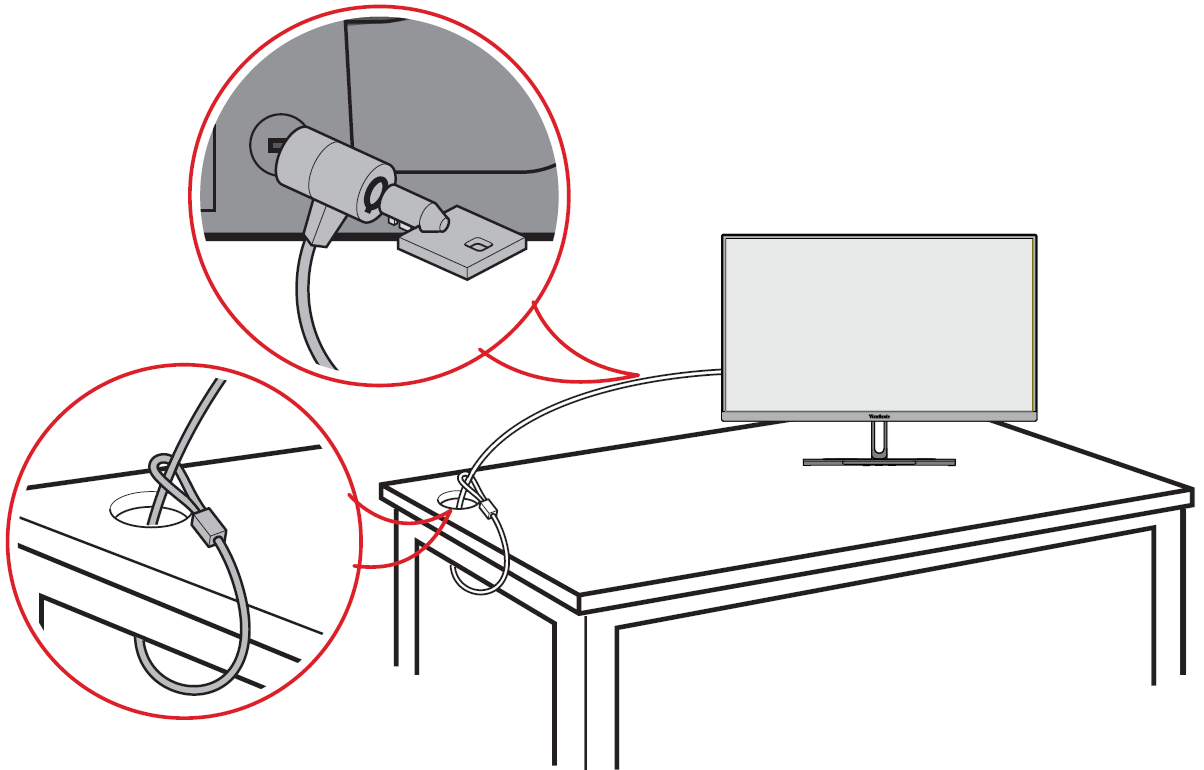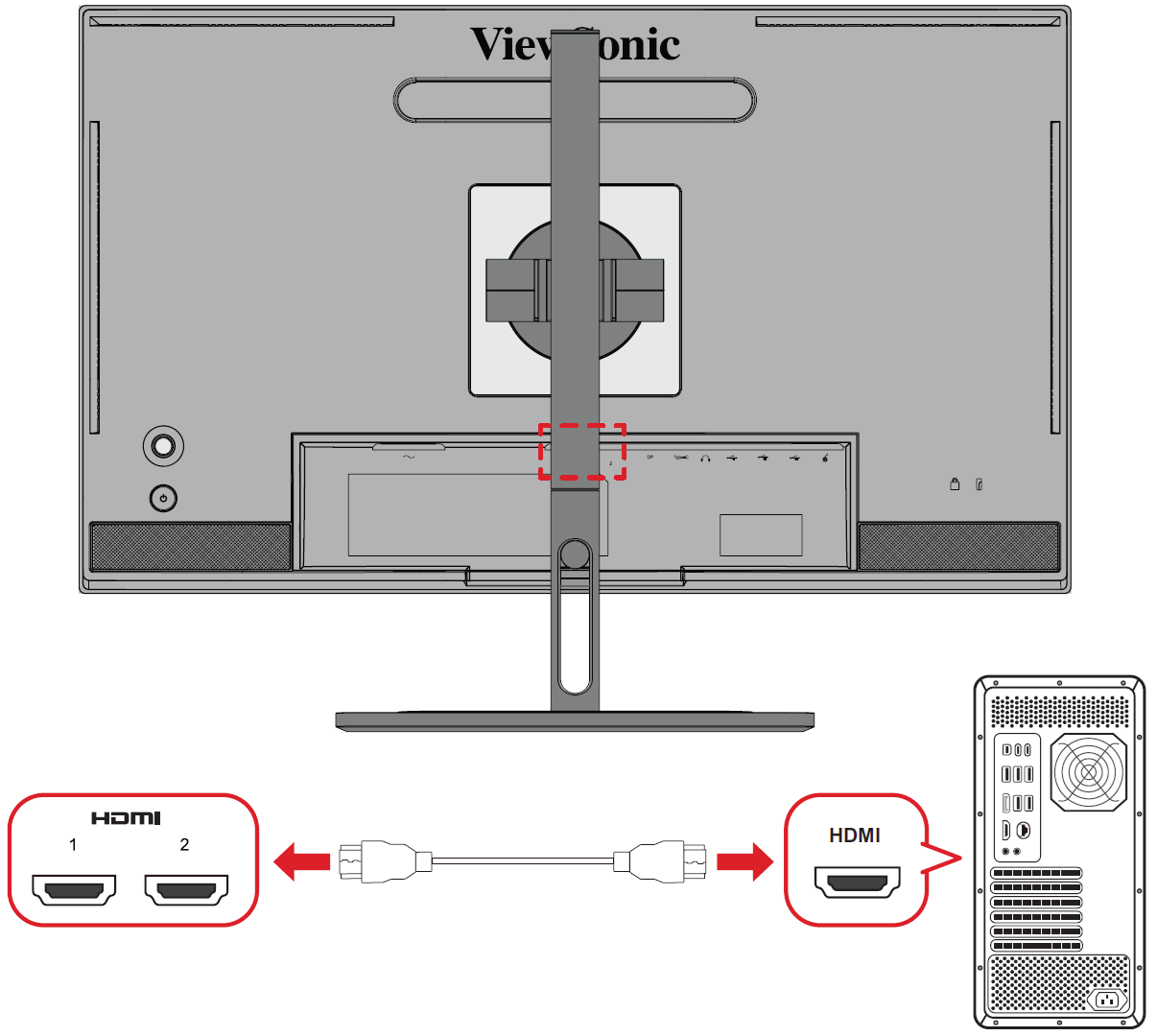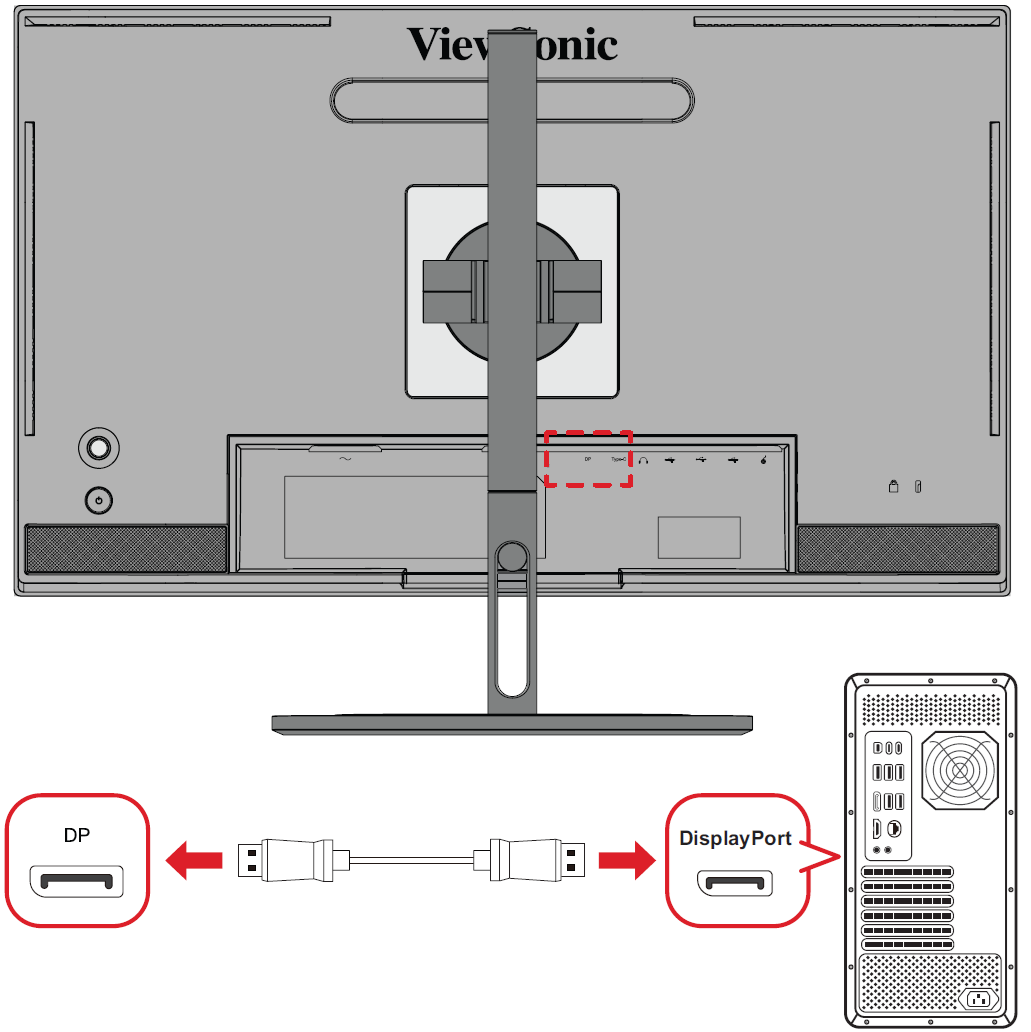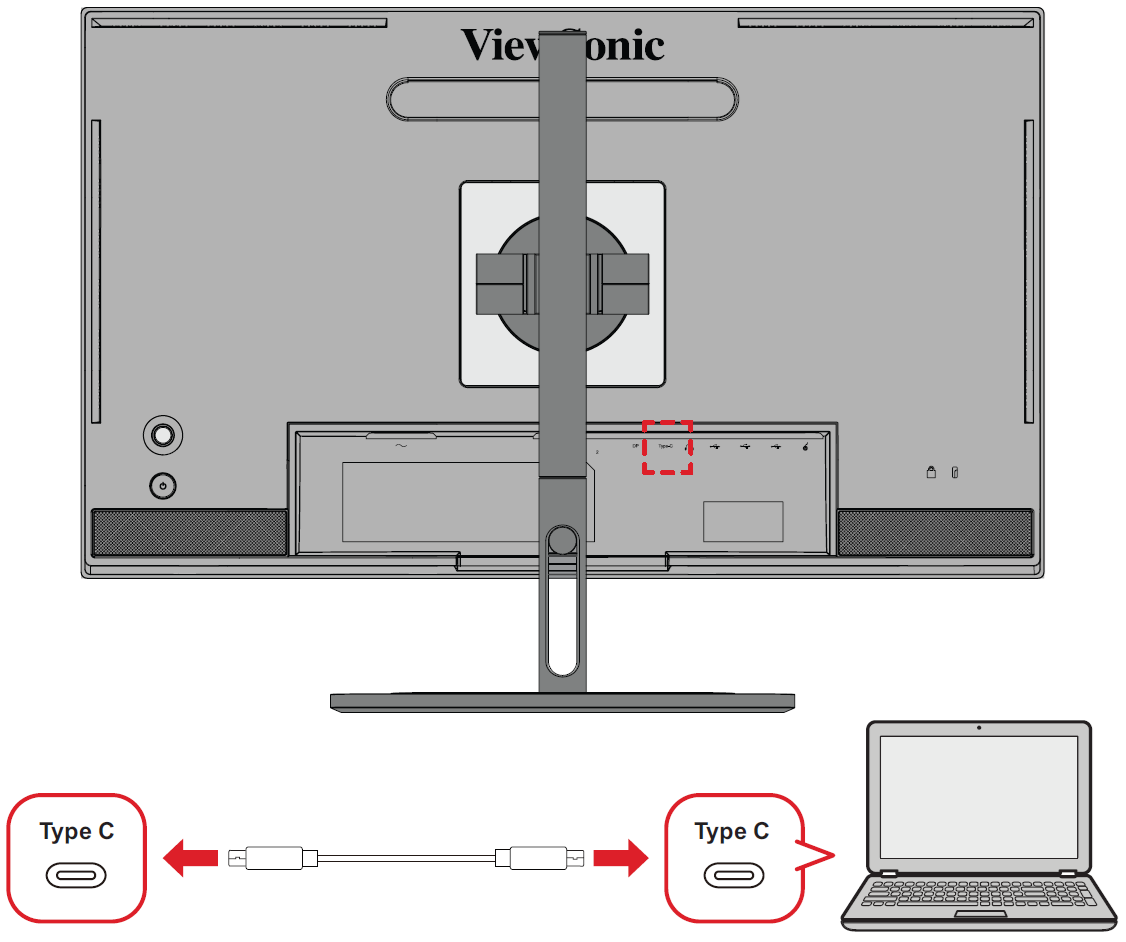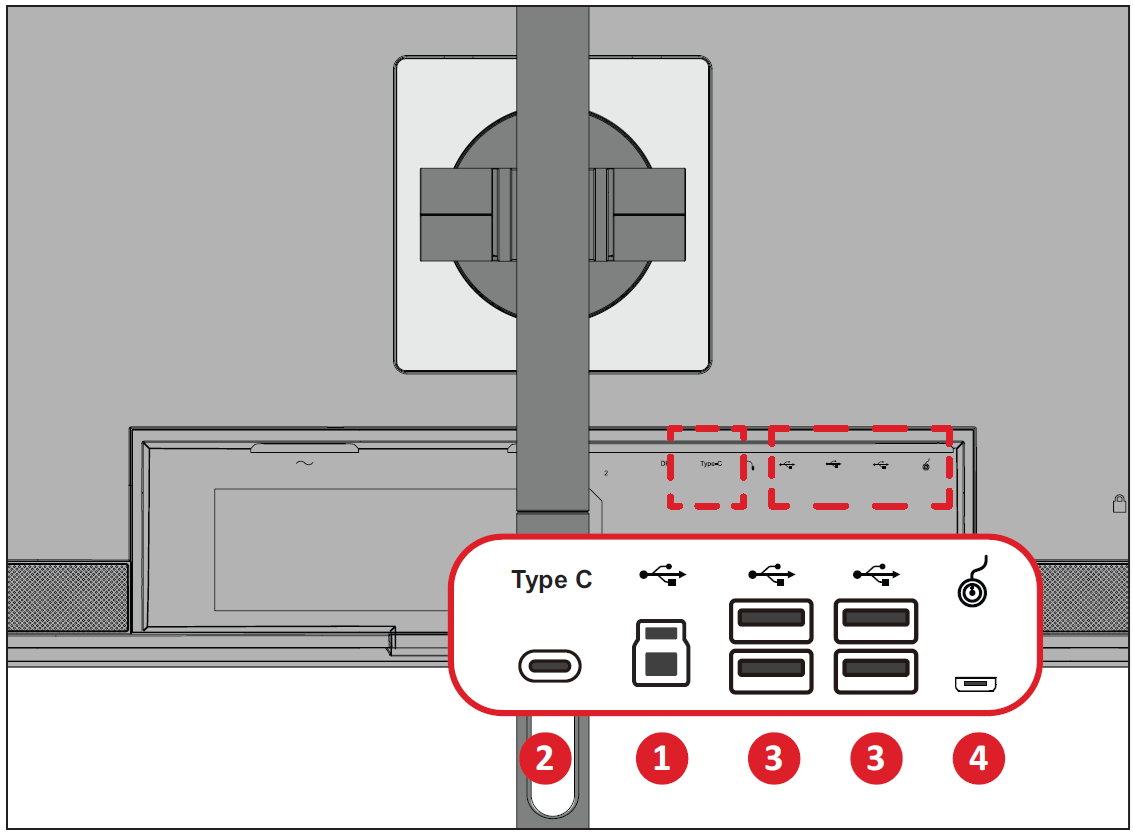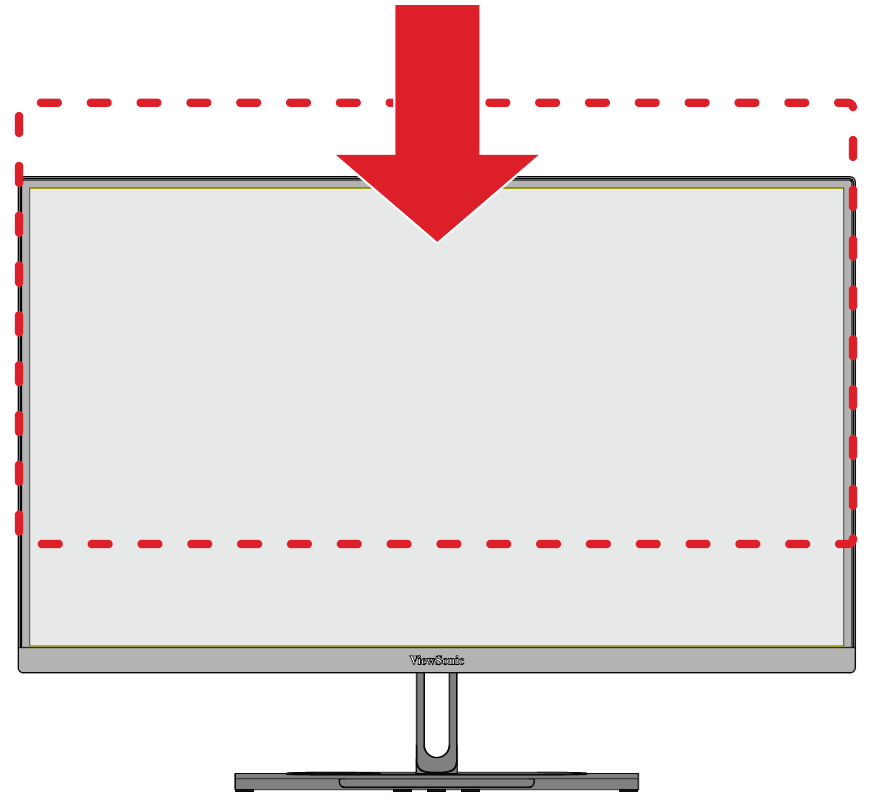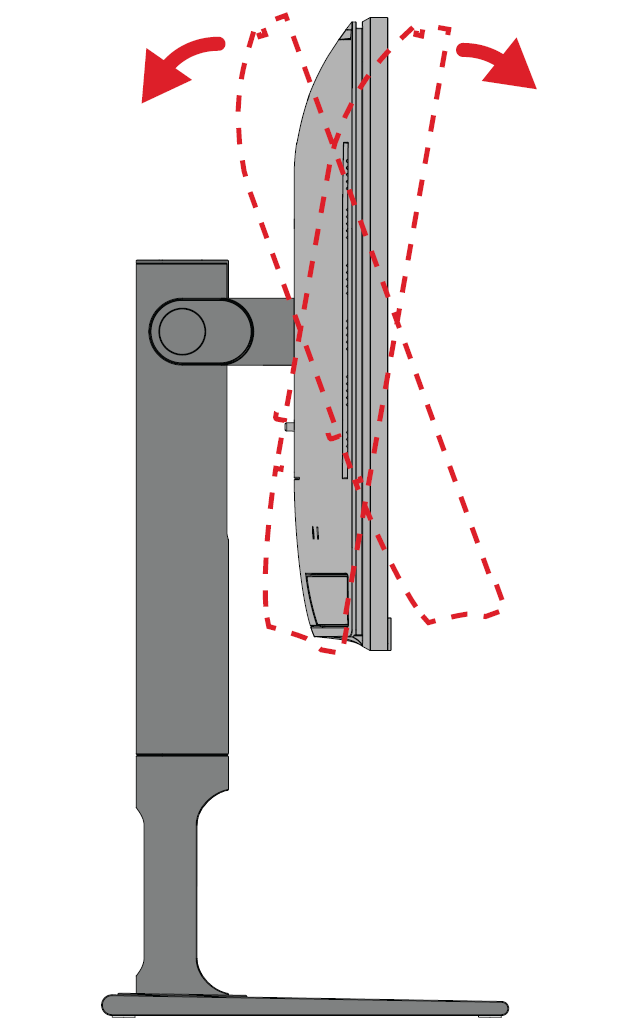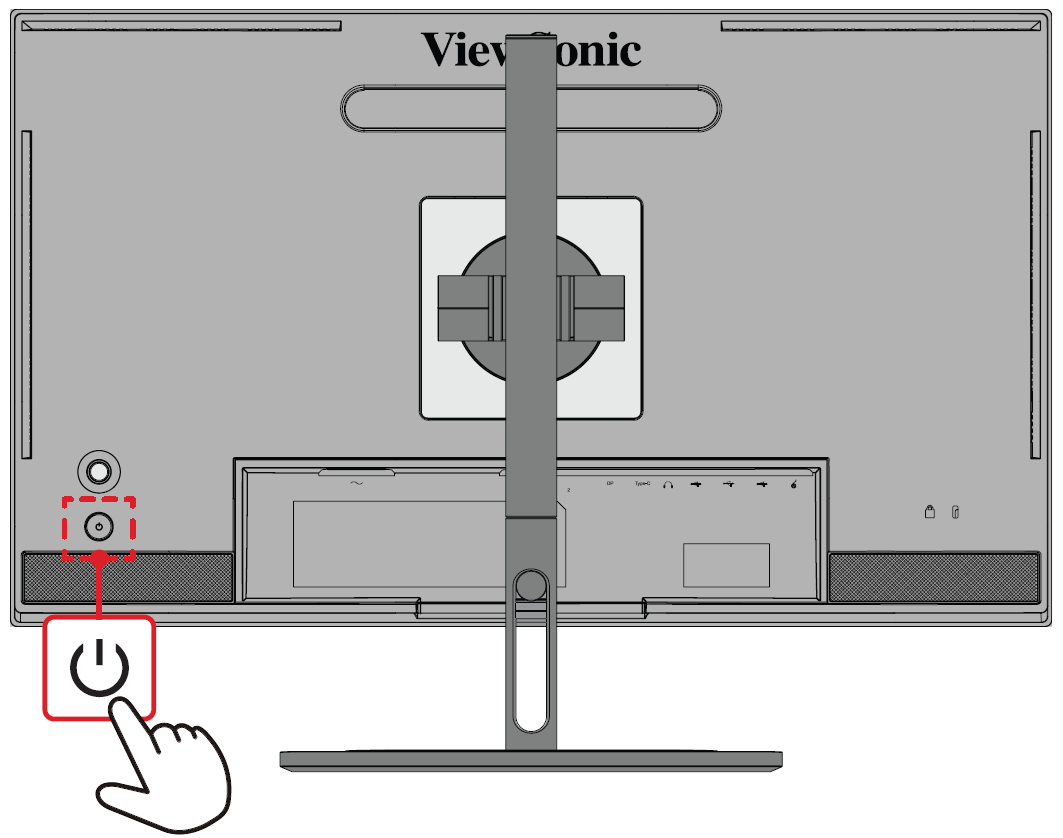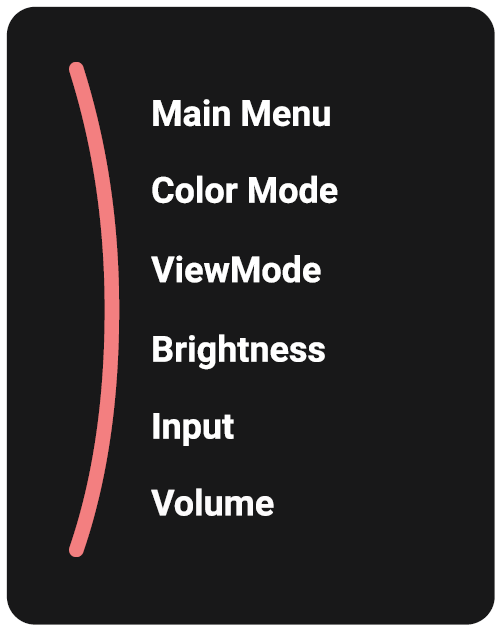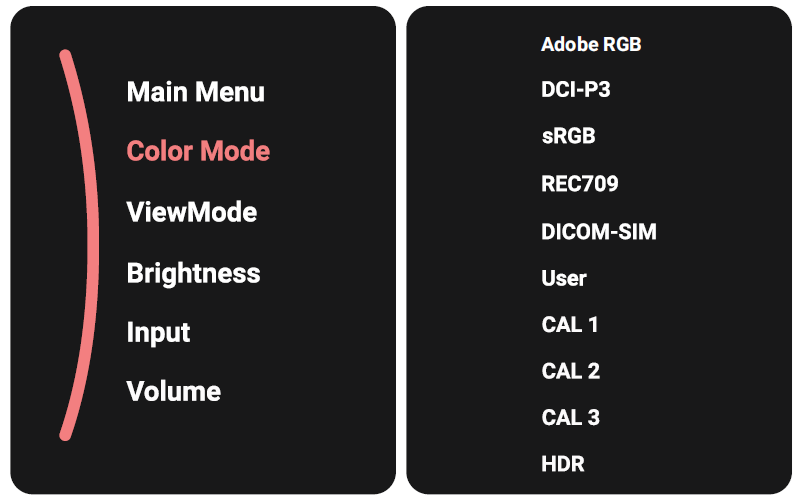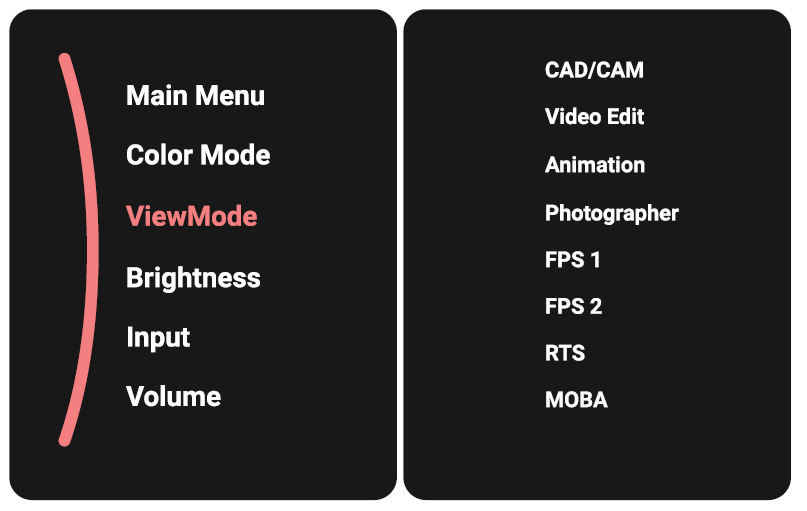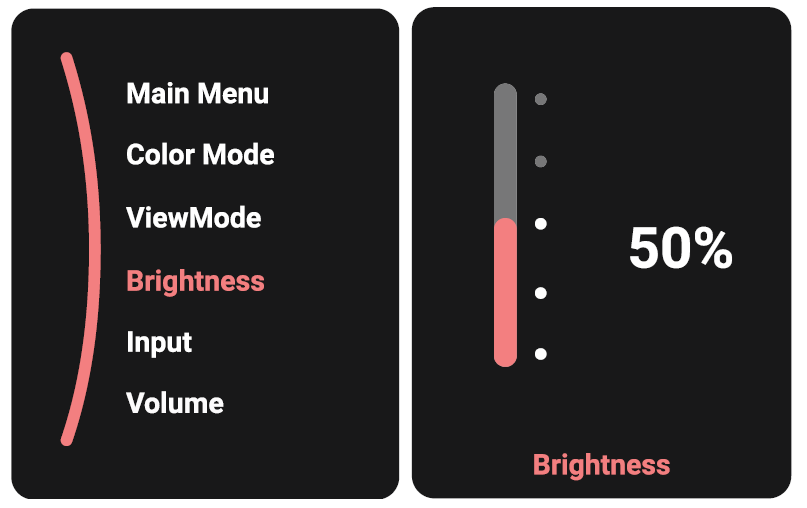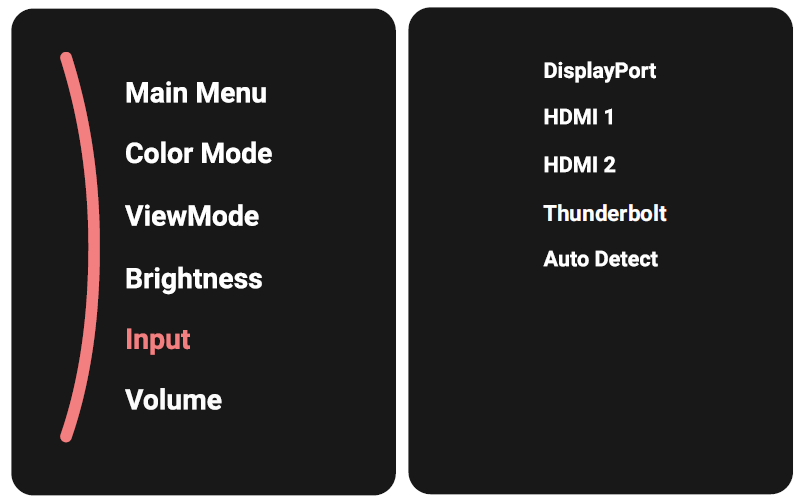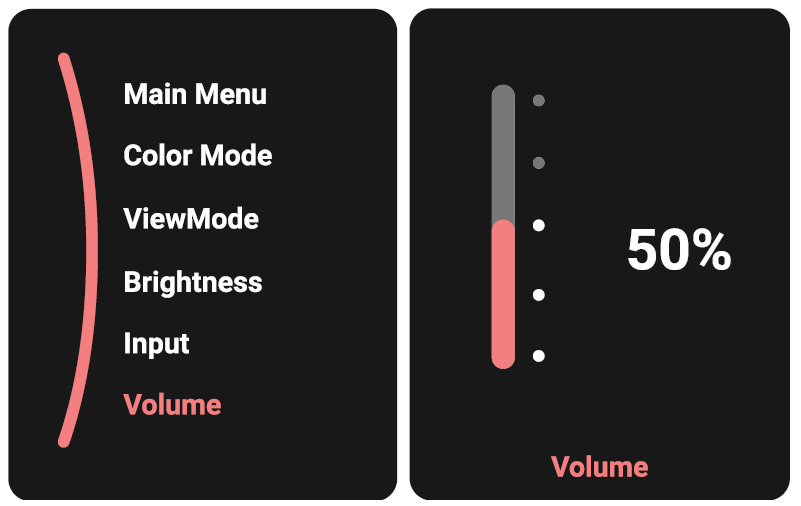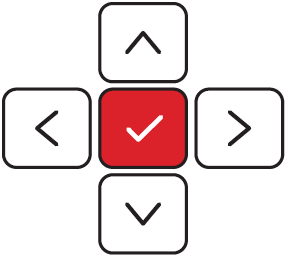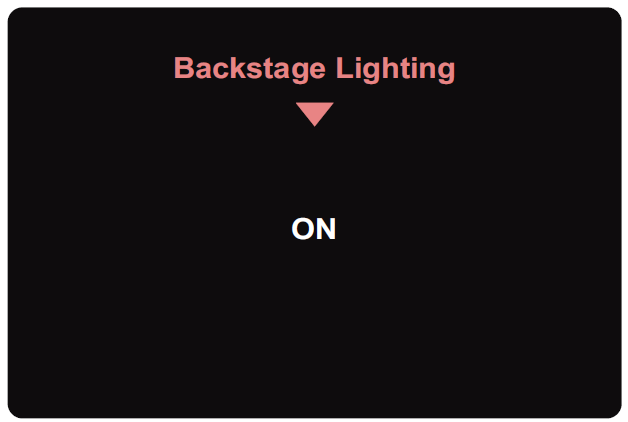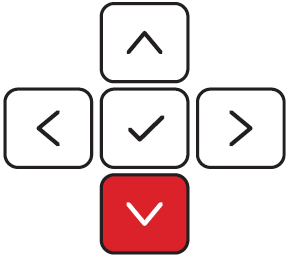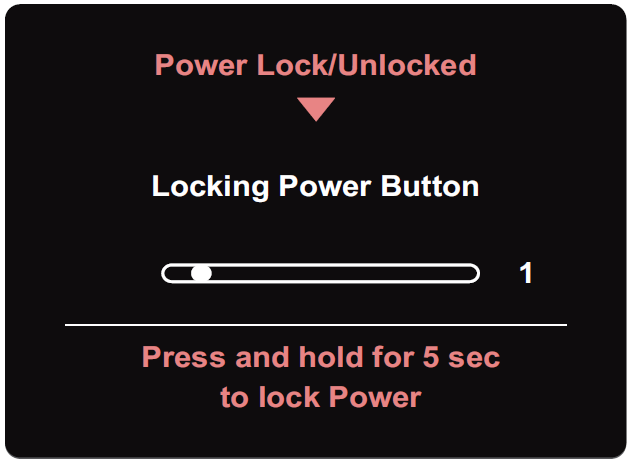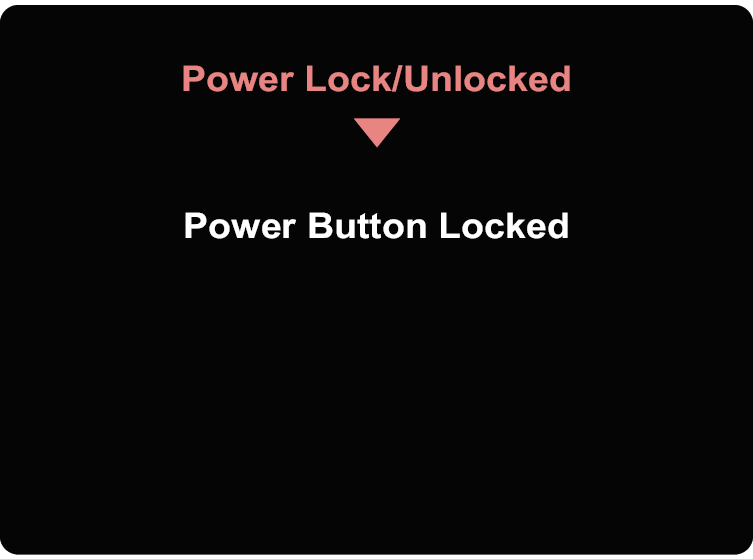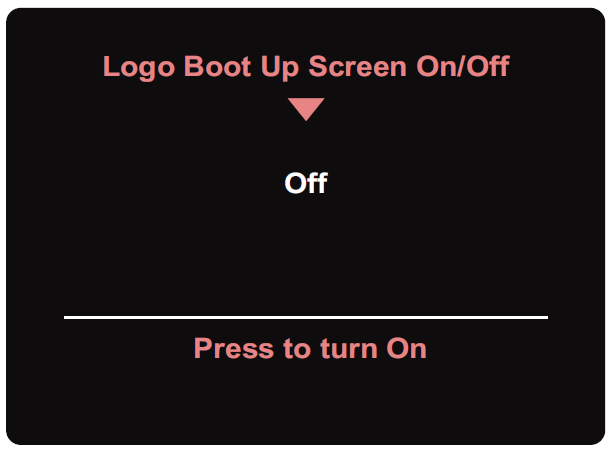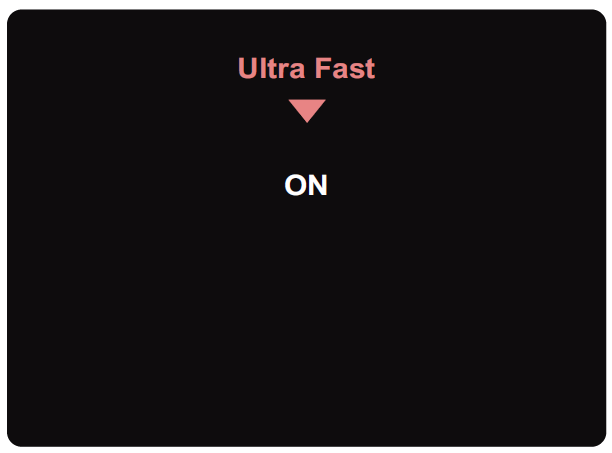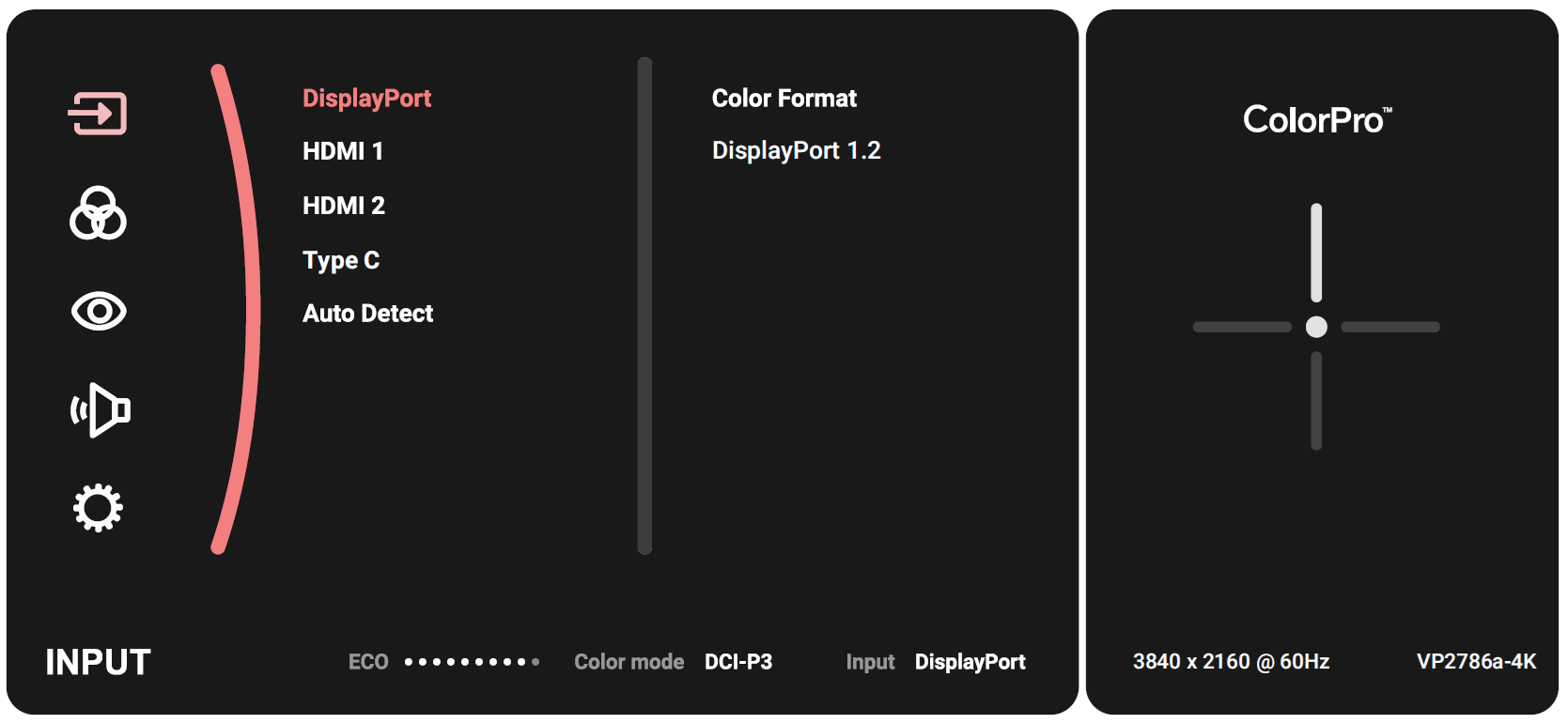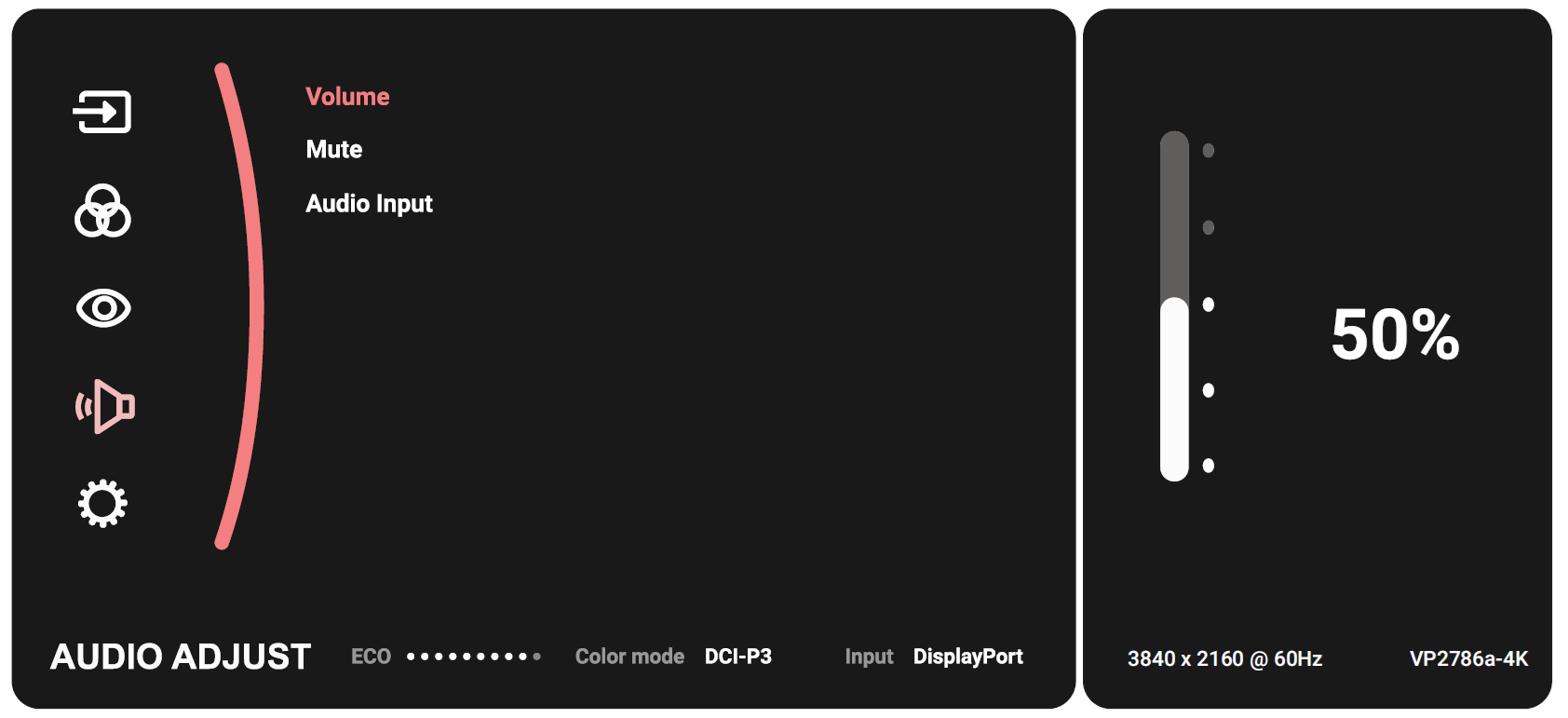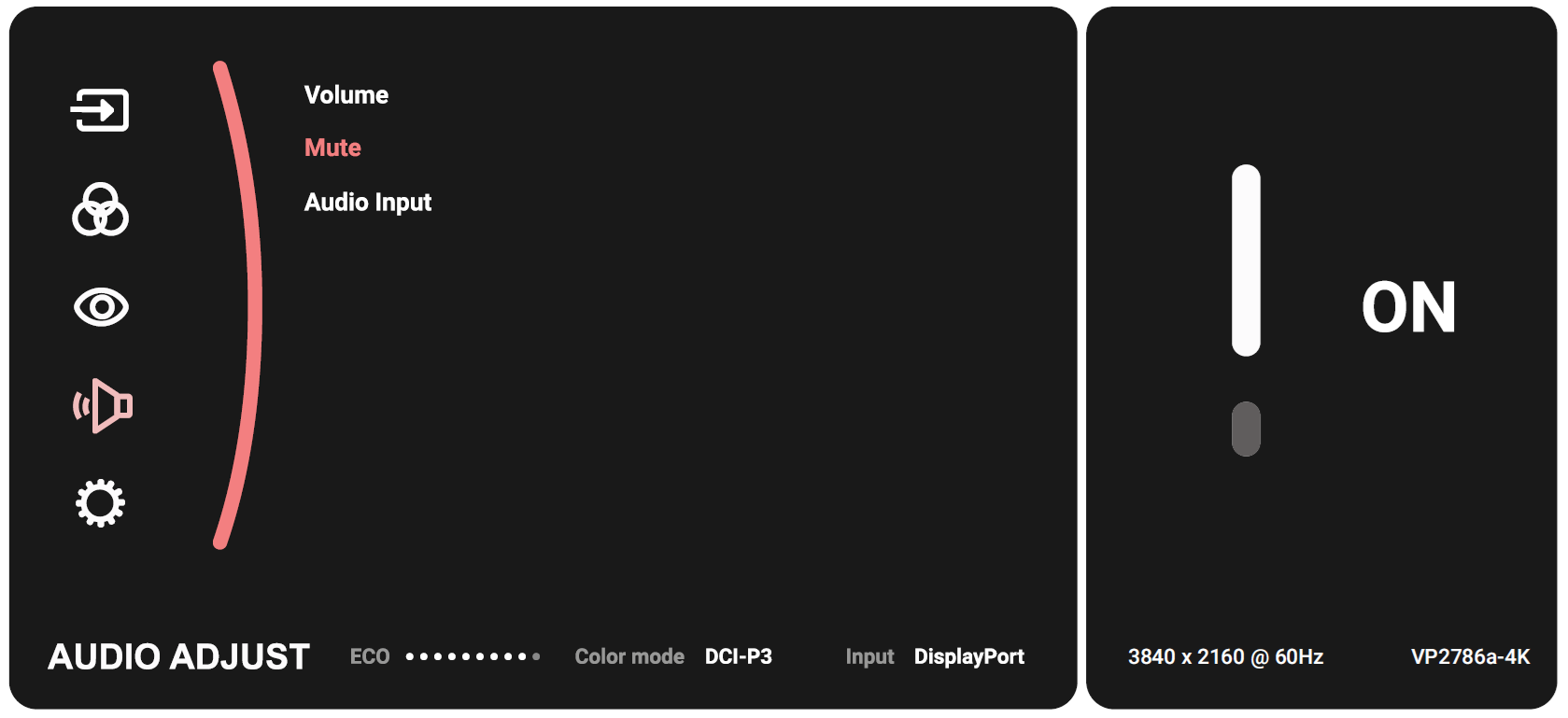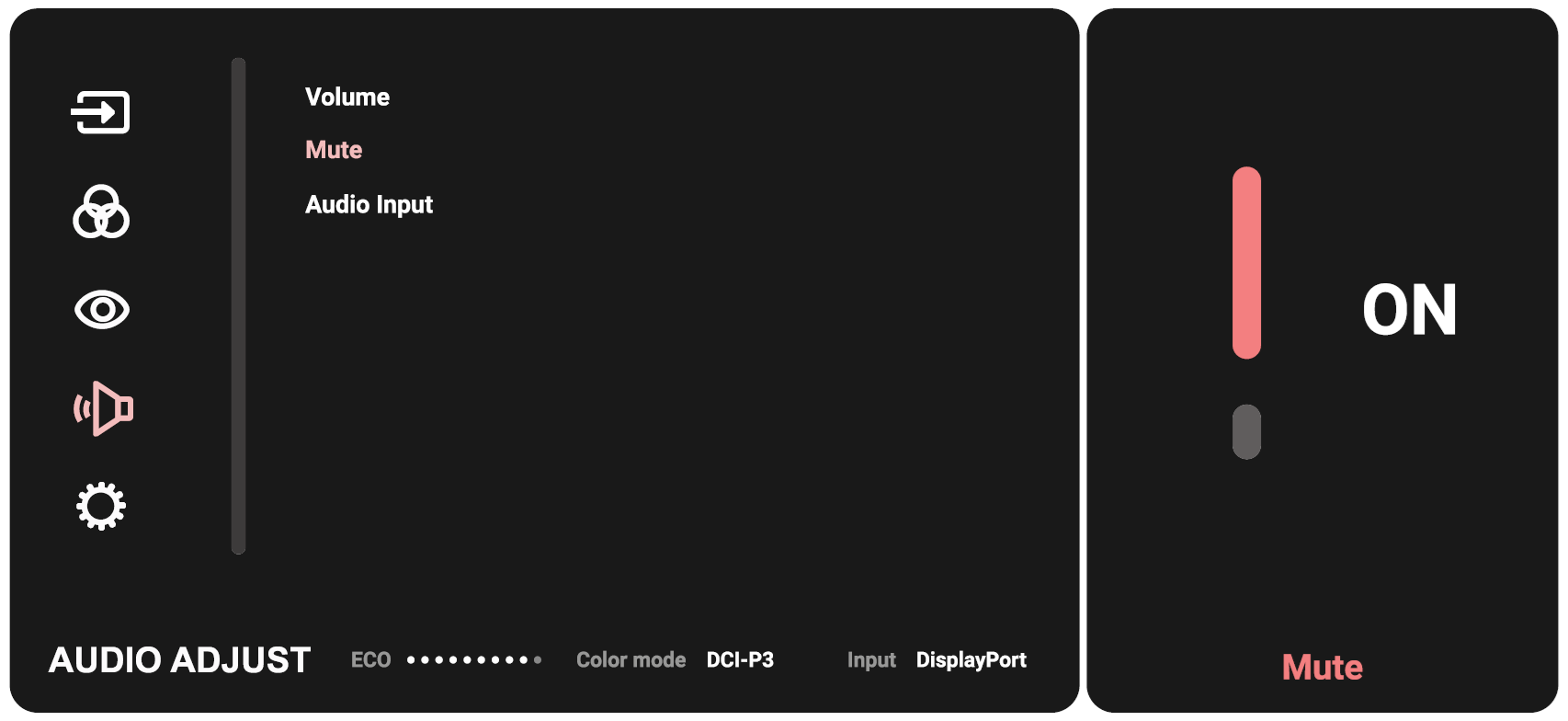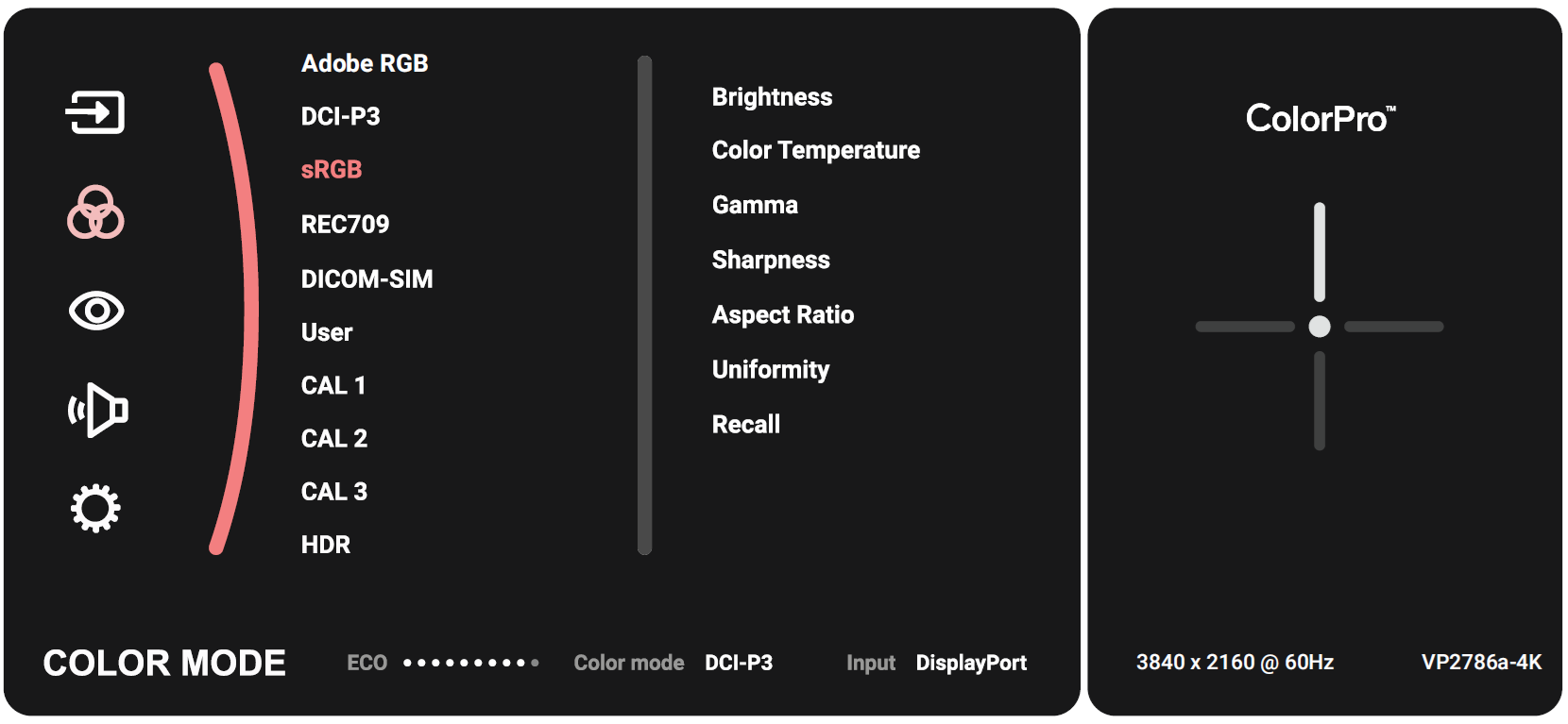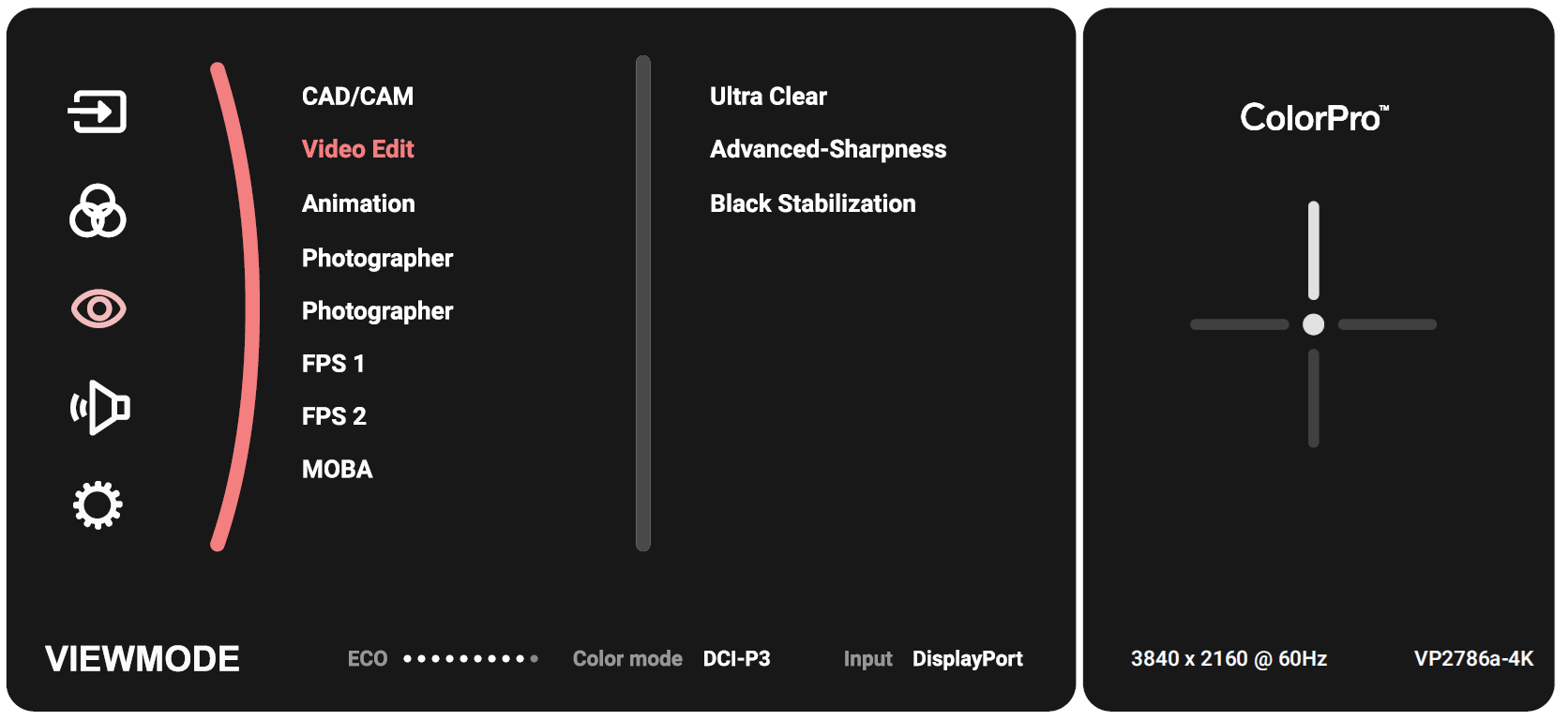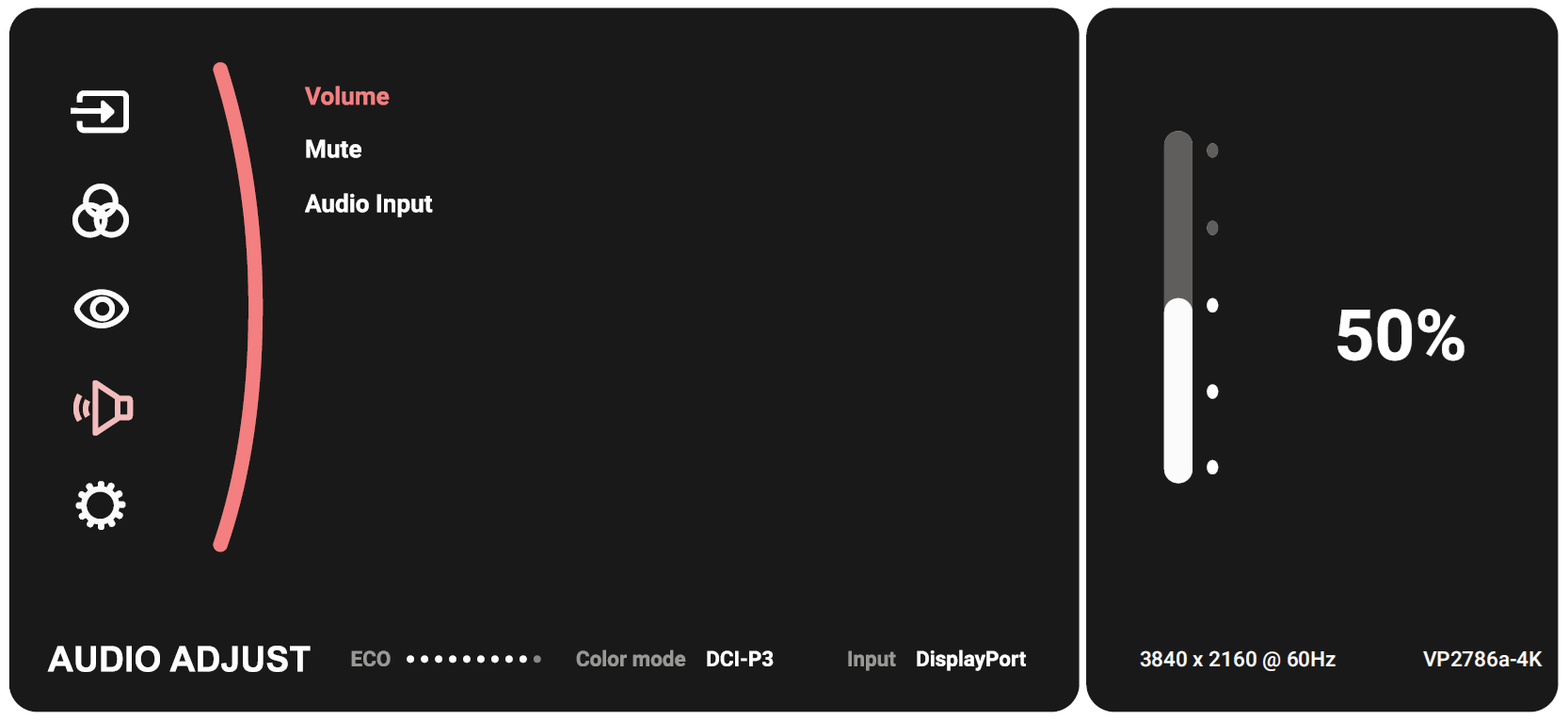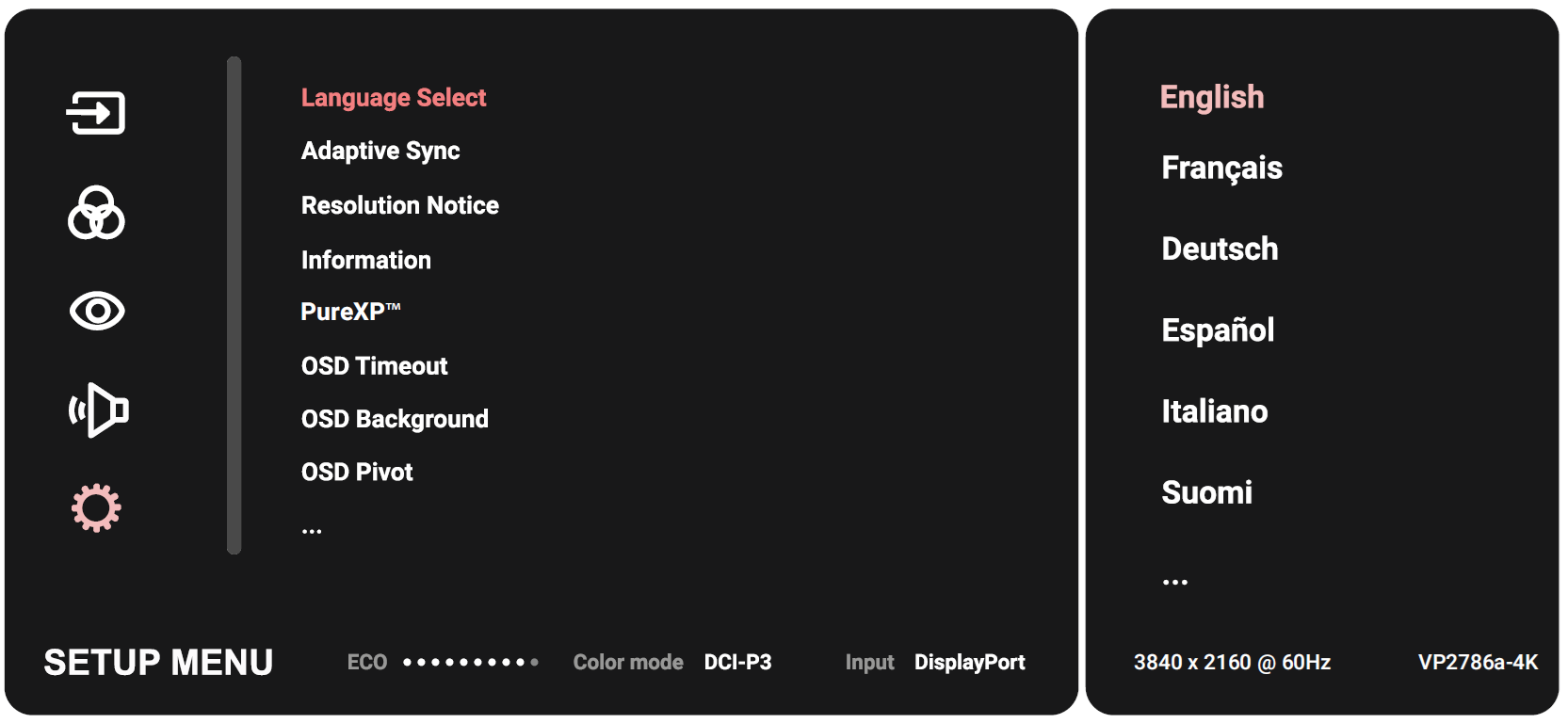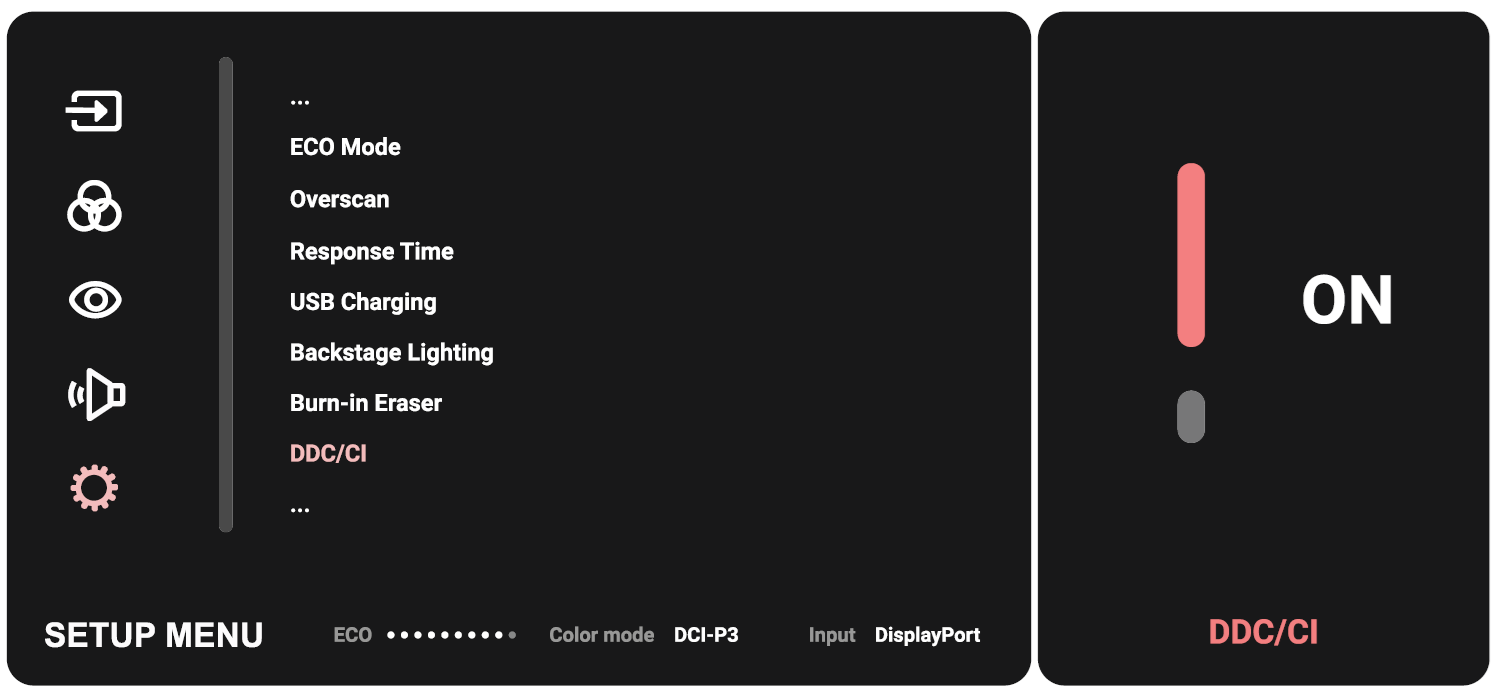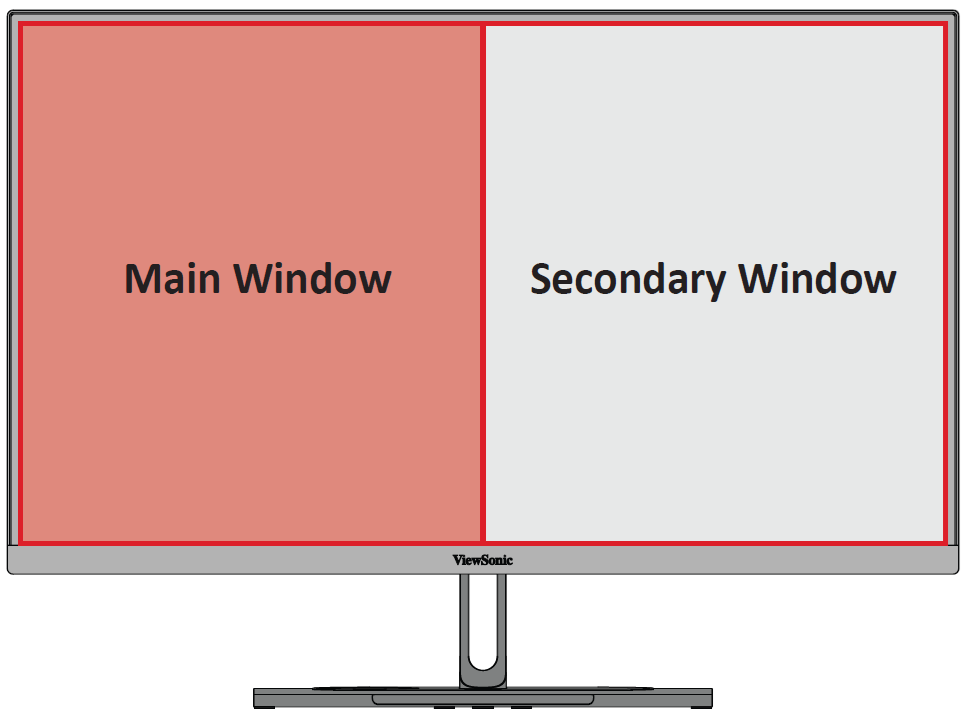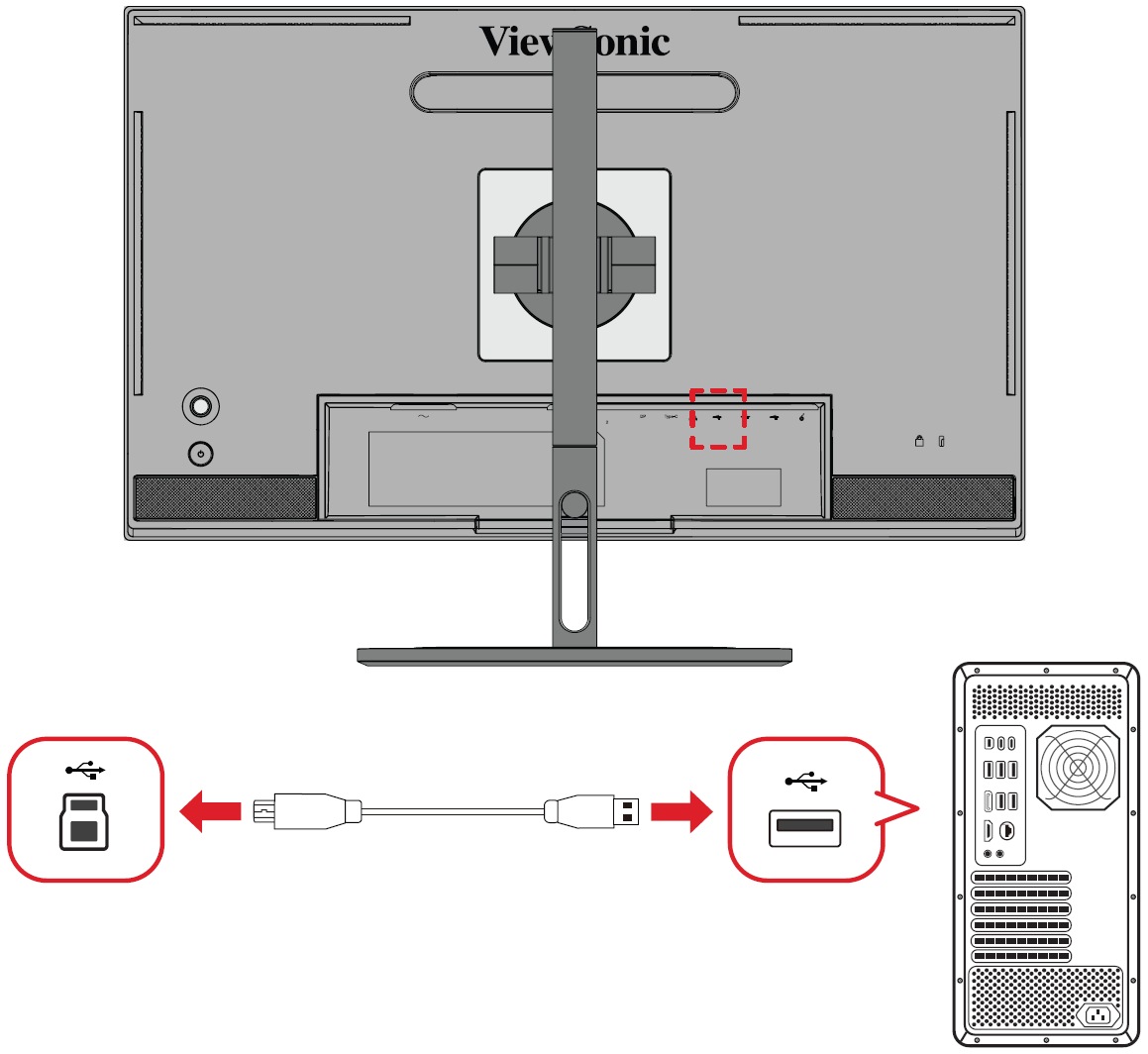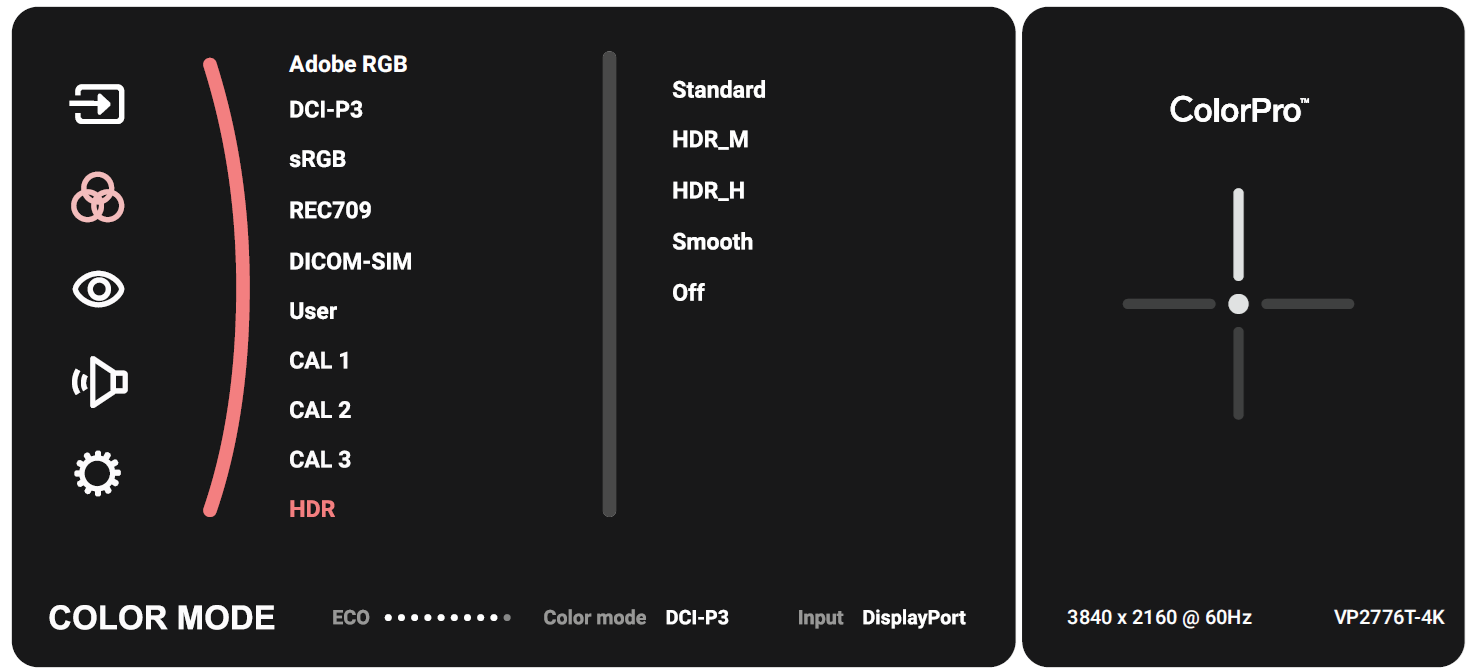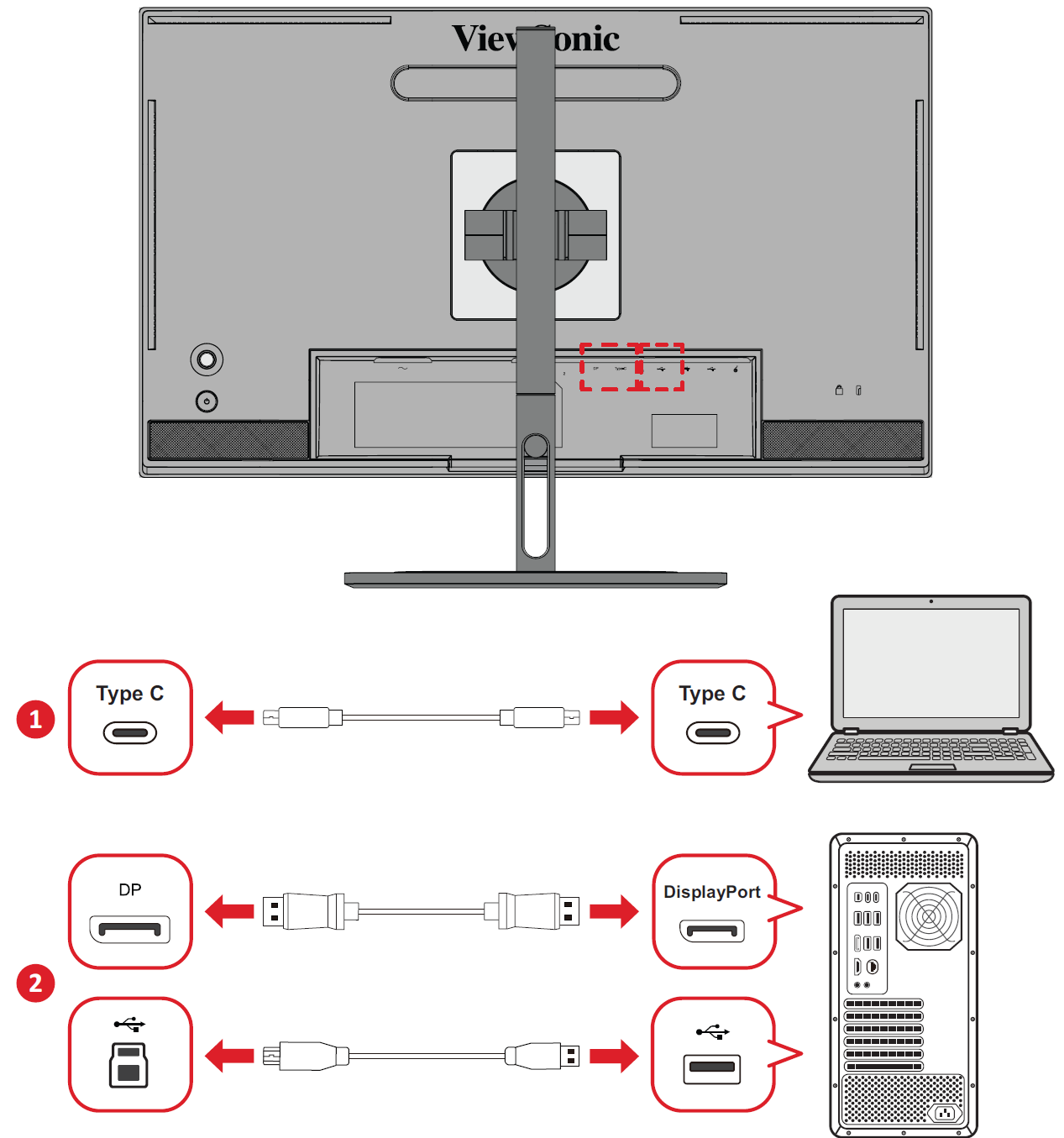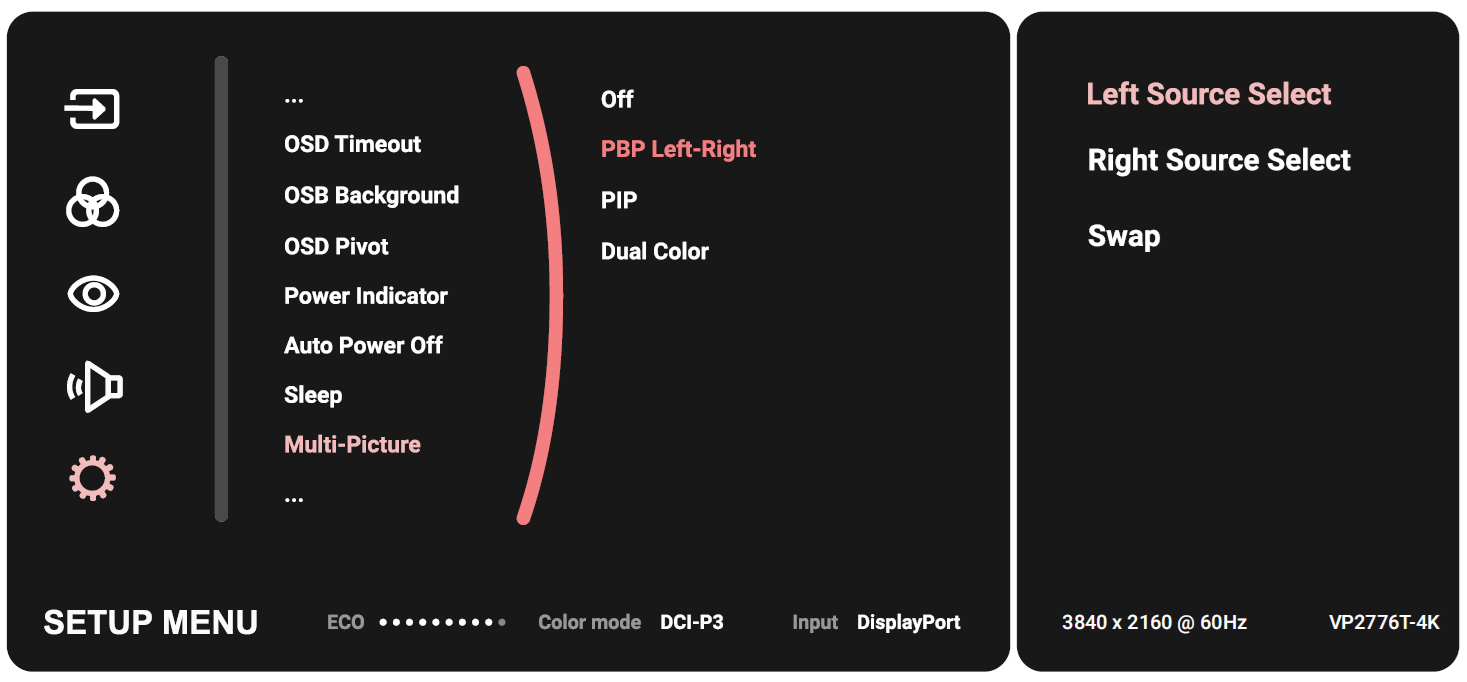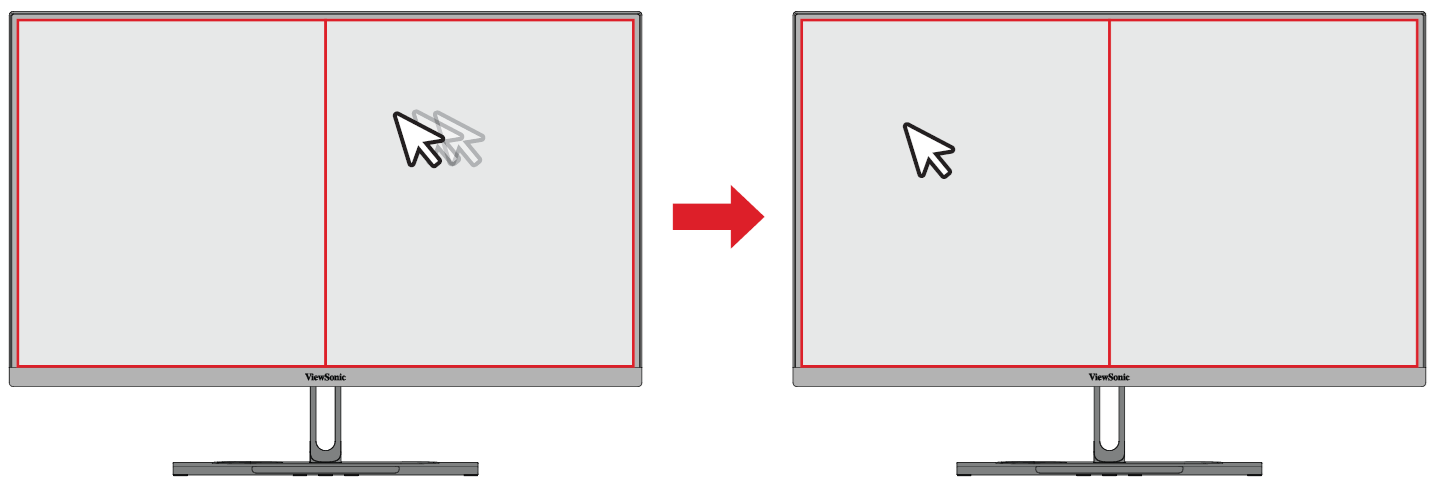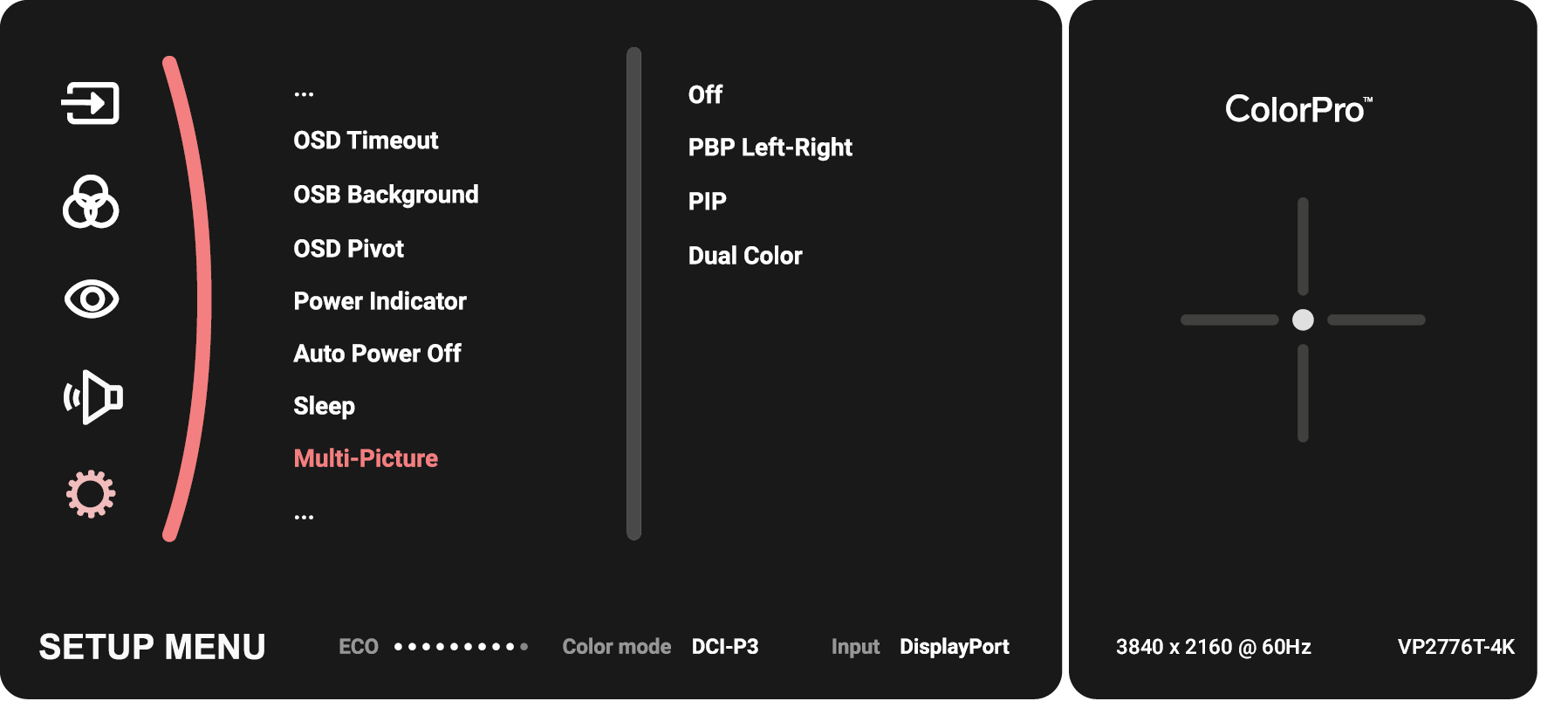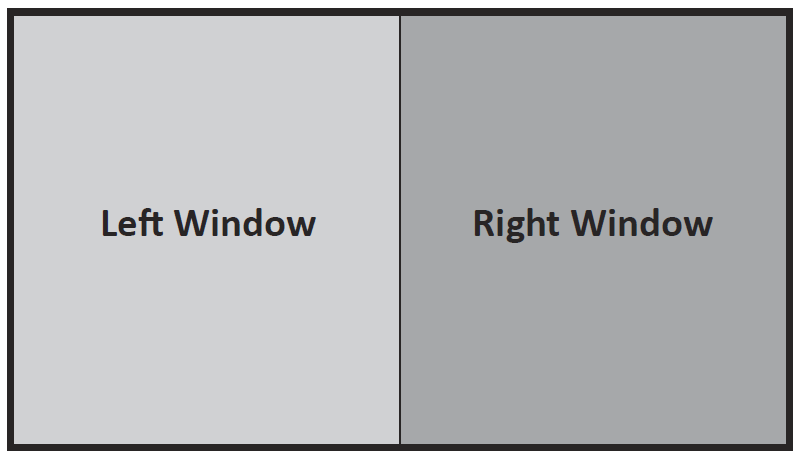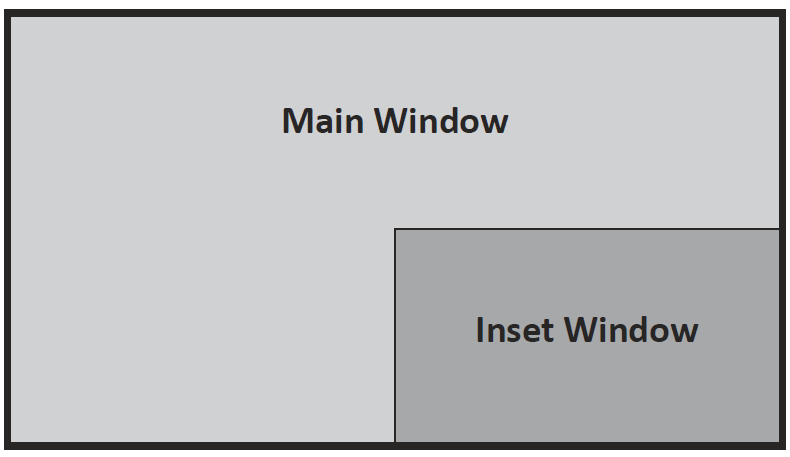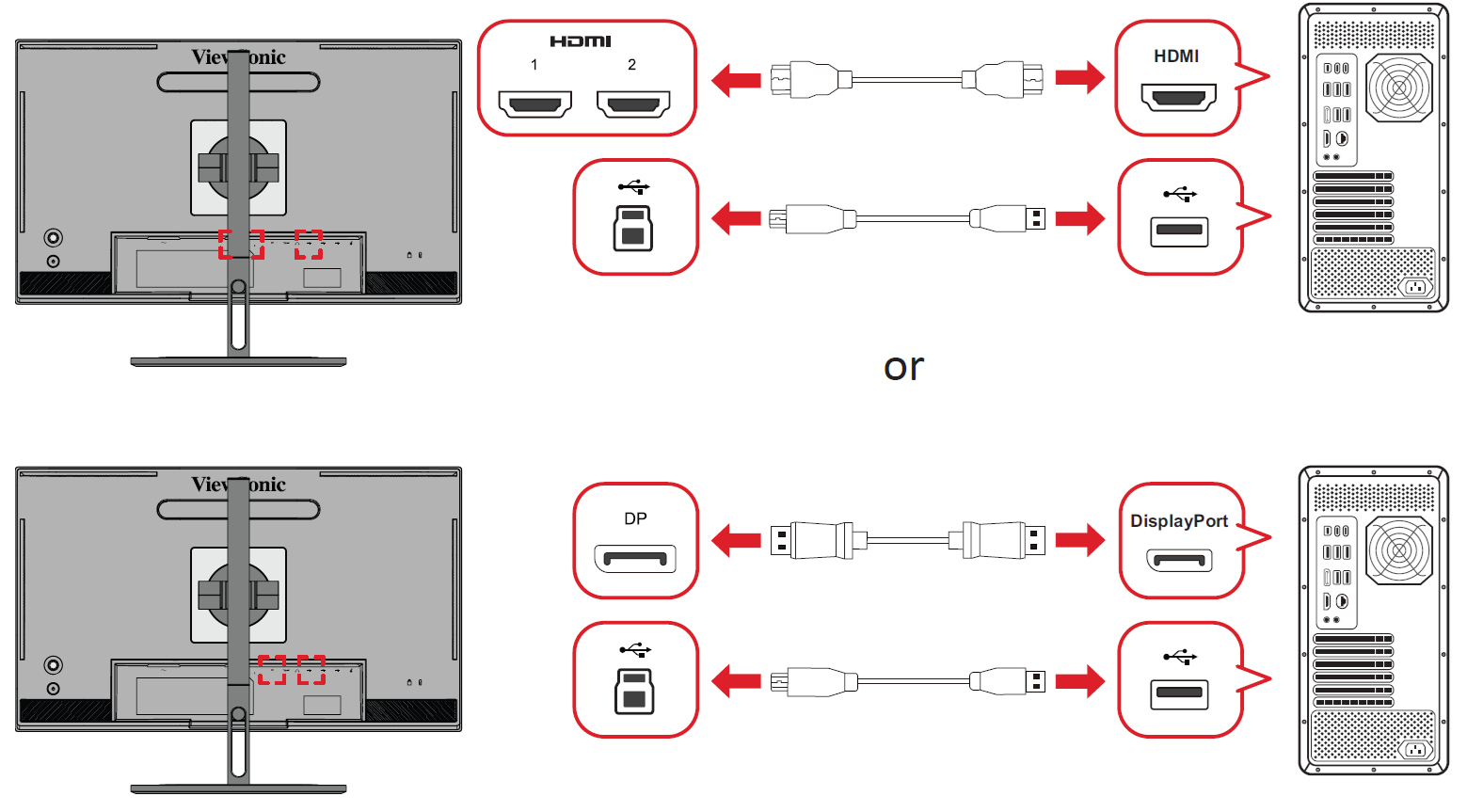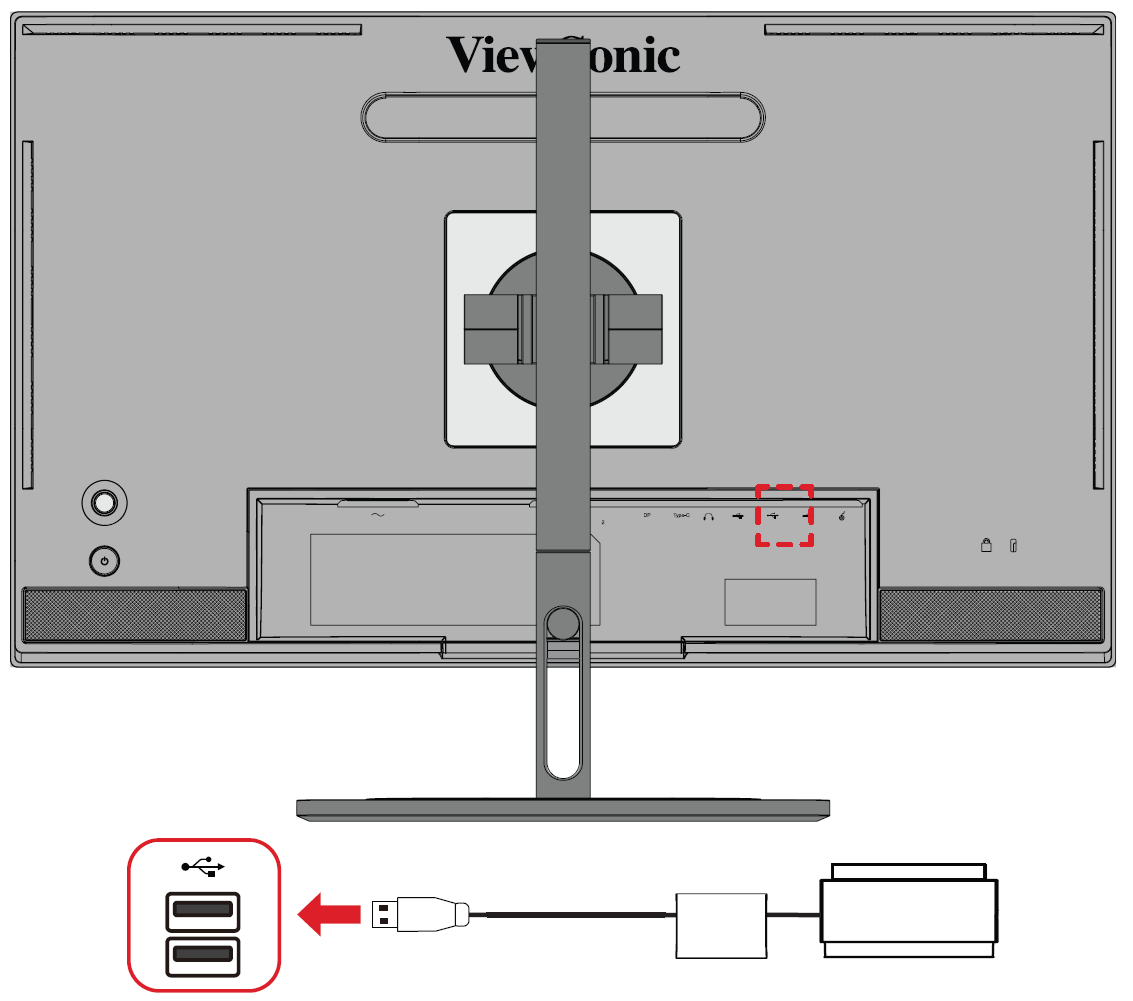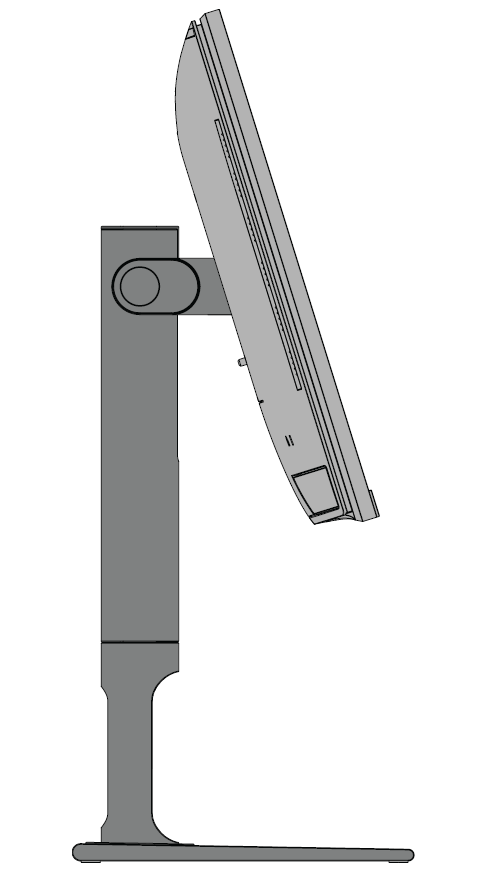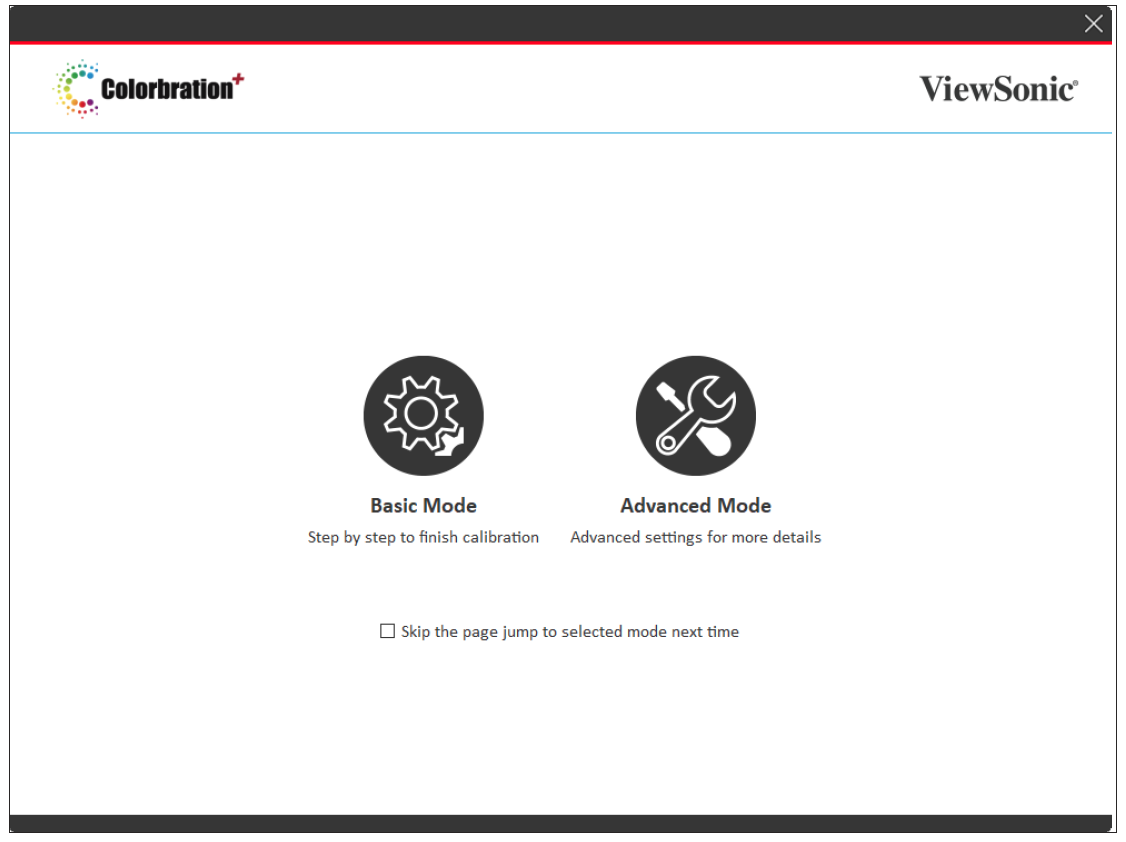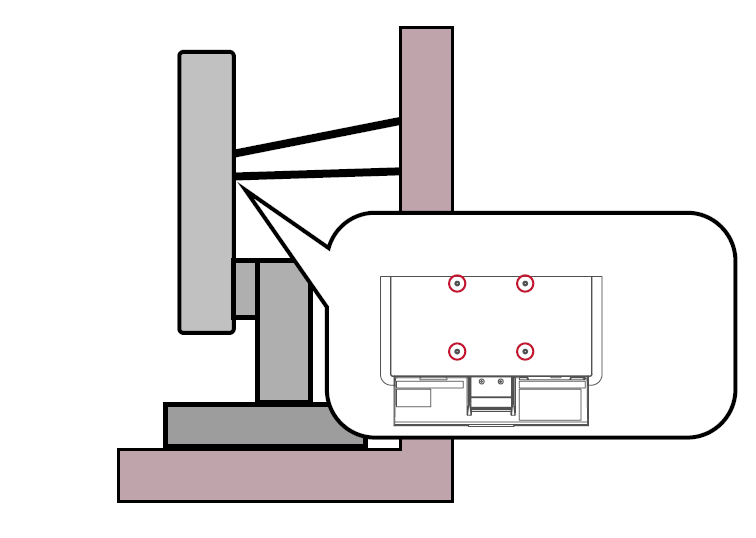
Introduction
Package Contents
- Monitor
- Power Cord
- Video Cable
- Quick Start Guide
Note: The cables included in your package may vary depending on your country. Please contact your local reseller for more information.
Product Overview
| Number |
Description
|
| 1
|
Joy Key
|
| 2
|
Power Button
|
| 3
|
I/O Ports
|
| 4
|
Security Lock Slot
|
I/O Ports
| Number |
Description
|
| 1 |
AC IN
|
| 2 |
HDMI
|
| 3 |
DisplayPort
|
| 4 |
USB Type C
|
| 5 |
Audio Out
|
| 6 |
USB Upstream
|
| 7 |
USb Downstream
|
| 8 |
Micro USB
|
Note: For more information about the (

/

/

/

/

) key and its functions, refer to
Hot Keys.
Initial Setup
Installing the Stand
- Place the monitor on a flat, stable surface with the screen facing down.
- Align and slide the upper hooks of the monitor stand into the stand mounting slots.
- Lift the monitor into its upright position on a flat, stable surface.
Note: For safety and to ensure optimal performance, please position the monitor on a flat, stable surface. Failure to do so may lead to the monitor falling, causing damage to the monitor itself and/or posing a risk of personal injury.
Removing the Stand and Mounting the Monitor
Refer to the table below for the standard dimensions for mounting kits.
Note: For use only with a UL certified mounting kit/bracket. To obtain a wall mounting kit or height adjustment base, contact ViewSonic® or your local dealer.
| Maximum Loading
|
Pad Hole
|
Screw Specification
|
Screw Quantity
|
| 14 kg
|
100 x 100 mm
|
M4 x 10 mm
|
4 screws
|
Note: Mounting kits are sold separately.
Important: Before removing the stand, turn off the monitor, disconnect all cables, and place the monitor on a flat, stable surface with the screen facing down.
- Press and hold the quick release tab and carefully lift the stand.
- Pull down slightly to disengage the hooks and remove the stand.
- Attach the mounting bracket to the VESA mounting holes at the rear of the monitor. Then secure it with four screws (M4 x 10 mm).
- Follow the instructions that come with the purchased or optional mounting kit to mount the monitor.
Using the Security Slot
To help prevent the monitor from being stolen, use a security slot locking device to secure the monitor to a fixed object.
Additionally, fastening the monitor to a wall or fixed object using a security cable can help support the weight of the monitor in order to prevent the monitor from falling over.
Making Connections
Connecting to Power
- Connect the power cord to the AC IN jack at the rear of the monitor.
- Plug the power cord plug into a power outlet.
Display Connection
HDMI
- Connect one end of an HDMI cable to an HDMI port of the monitor.
- Plug the other end of the cable into the HDMI port of your computer.
DisplayPort
- Connect one end of a DisplayPort cable to the DP port of the monitor.
- Plug the other end of the cable into the DisplayPort or Mini DisplayPort port of your computer.
Note: To connect the monitor to the Thunderbolt port (v. 1 & 2) on your Mac, connect the Mini DisplayPort end of a “Mini DisplayPort to DisplayPort cable” to the Thunderbolt output port of your Mac. Then connect the other end of the cable to the DisplayPort port of the monitor.
Type C
- Connect one end of a USB Type C cable to the Type C port of the monitor.
- Plug the other end of the cable into the USB Type C port of your computer.
Note: For video output use, make sure your USB Type C output device (e.g., laptop) and cable support video signal transmission.
USB Connection
The monitor supports two types of USB ports, upstream and downstream. When making connection(s), observe the following guideline.
| USB Type
|
Connection Type
|
Description
|

|
Upstream
|
Type B
|
Transfers data between the computer and the USB devices connected to the monitor.
|

|
Downstream
|
Type C
|
Transfers audio, video, and power. Enables the KVM function.
|
| Supports 5V/3A, 9V/3A, 12V/3A, 15V/3A, 20V/3.25A (LPS) charging.
|

|
Type A
|
For peripheral device(s) (e.g., storage device, keyboard, mouse, etc.).
|
| Supports 5V/2A charging.
|

|
Micro USB
|
For use with the ColorPro™ Wheel only.
|
Note: To use peripheral devices with the USB Type A ports, please also connect your computer to the monitor’s USB Type B port.
Using the USB Ports
- To use the downstream USB Type A ports, connect one end of the USB Type B cable to the upstream USB Type B port of the monitor. Plug the other end of the cable, USB Type A, into a USB port of your computer.
- Connect your peripheral device(s) to a downstream USB Type A port of the monitor.
Audio Connection
Plug the audio jack of the audio device into the Audio Out port of the monitor.
Note: The monitor is also equipped with dual speakers.
Using the Monitor
Adjusting the Viewing Angle
Height Adjustment
Lower or raise the monitor to the desired height (0 to 130 mm).
Note: When adjusting, press down firmly along the adjustment track holding the monitor with both hands on the side.
Screen Orientation Adjustment (Monitor Pivot)
- Adjust the monitor height to the highest position. Then tilt the monitor backwards to the full tilt position.
- Rotate the monitor 90° clockwise or counterclockwise (3) from landscape to portrait orientation.
Note:
- When adjusting, make sure to hold both sides of your monitor firmly with both hands.
- If using the Auto Pivot function, the system can detect the screen orientation automatically.
Swivel Adjustment
Swivel the monitor to the left or right for the desired viewing angle (60˚).
Tilt Adjustment
Tilt the monitor forwards or backwards to the desired viewing angle (-5˚ to 21˚).
Note: When adjusting, support the stand firmly with one hand while tilting the monitor forwards or backwards with the other hand.
Turning the Monitor On/Off
- Plug the connected power adapter into a power outlet.
- Press the Power ( ) button to turn on the monitor.
- To turn the monitor off, press the Power ( ) button again.
Note:
- If the OSD Menu is still on screen, press and hold the Power ( ) button for three seconds to power off.
- The monitor will still consume some power as long as the power cord is connected to the power outlet. If the monitor is not being used for a long period of time, please disconnect the power plug from the power outlet.
Using the Joy Key
Use the Joy Key to activate Hot Keys, navigate the On-Screen Display (OSD) Menu, and change settings.
Move the Joy Key (  ) to activate the Startup Menu.
) to activate the Startup Menu.
Note: Follow the key guide that appears on the screen to select the option or make adjustments.
Main Menu
Enter the On-Screen Display (OSD) Menu.
Color Mode
Select one of the preset standard color settings.
ViewMode
Select one of the preset display settings.
Brightness
Adjust the brightness level.
Input
Select the input source.
Volume
Adjust the volume settings.
Note: Move the
Joy Key (

) to return to the previous menu.
Hot Keys
When the On-Screen Display (OSD) Menu is off, you can quickly access special functions by using the Joy Key.
| Key
|
Description
|
|
|
Press and hold the key for five seconds to activate/deactivate LED lighting.
|
|
|
Press and hold the key to lock/unlock the OSD Menu.
When the menu appears on the screen, continue holding the key for 10 seconds to lock/unlock the OSD Menu.
If the OSD Menu is locked, the below message will appear on the screen:
|
|
|
Press and hold the key to lock/unlock the Power ( ) button.
When the menu appears on the screen, continue holding the key for 10 seconds to lock/unlock the Power ( ) button.
If the Power ( ) button is locked, the below message will appear on the screen.
|
|
|
Press and hold the key for 10 seconds to display/hide the boot up screen when the device is turned on.
|
|
|
Press and hold the key for 10 seconds to activate/deactivate Ultra Fast.
|
Configuring the Settings
General Operations
- Move the Joy Key (
 ) to display the Startup Menu. Then navigate to Main Menu and press the Joy Key (
) to display the Startup Menu. Then navigate to Main Menu and press the Joy Key (  ) to display the OSD Menu.
) to display the OSD Menu.
- Move the Joy Key (
 ) or (
) or (  ) to select the main menu. Then press the Joy Key (
) to select the main menu. Then press the Joy Key (  ) to enter the selected menu.
) to enter the selected menu.
- Move the Joy Key (
 ) or (
) or (  ) to select the desired menu option. Then press the Joy Key (
) to select the desired menu option. Then press the Joy Key (  ) to enter the sub-menu.
) to enter the sub-menu.
- Move the Joy Key (
 ) or (
) or (  ) to adjust/select the setting. Then press the Joy Key (
) to adjust/select the setting. Then press the Joy Key (  ) to confirm.
) to confirm.
- Move the Joy Key (
 ) to return to the previous menu.
) to return to the previous menu.
Input
- Move the Joy Key (
 ) to display the Startup Menu. Then navigate to Main Menu and press the Joy Key (
) to display the Startup Menu. Then navigate to Main Menu and press the Joy Key (  ) to display the OSD Menu.
) to display the OSD Menu.
- Move the Joy Key (
 ) or (
) or (  ) to select Input. Then press the Joy Key (
) to select Input. Then press the Joy Key (  ) to enter the Input menu.
) to enter the Input menu.
- Move the Joy Key (
 ) or (
) or (  ) to select the desired input source. Then press the Joy Key (
) to select the desired input source. Then press the Joy Key (  ) to confirm the selection.
) to confirm the selection.
Color Mode
- Move the Joy Key (
 ) to display the Startup Menu. Then navigate to Main Menu and press the Joy Key (
) to display the Startup Menu. Then navigate to Main Menu and press the Joy Key (  to display the OSD Menu.
to display the OSD Menu.
- Move the Joy Key (
 ) or (
) or (  ) to select Color Mode. Then press the Joy Key (
) to select Color Mode. Then press the Joy Key (  ) to enter the Color Mode menu.
) to enter the Color Mode menu.
- Move the Joy Key (
 ) or (
) or (  ) to select the desired option. Then press the Joy Key (
) to select the desired option. Then press the Joy Key (  ) to enter its sub-menu.
) to enter its sub-menu.
- Move the Joy Key (
 ) or (
) or (  ) to adjust/select the setting, and press the Joy Key (
) to adjust/select the setting, and press the Joy Key (  ) to confirm the selection (if applicable).
) to confirm the selection (if applicable).
| Menu Option
|
Description
|
| Adobe RGB
|
Precise color gamut and gamma of Adobe RGB standard.
|
| DCI-P3
|
Precise color gamut and gamma of DCI-P3 standard.
|
| sRGB
|
Precise color gamut and gamma of sRGB standard.
|
| REC709
|
Precise color gamut and gamma of ITU-R Rec. 709 standard.
|
| DICOM-SIM
|
Gamma curves are set to a DICOM simulation.
|
| User
|
Custom, user-defined settings.
|
| CAL1/CAL2/CAL3
|
Display with the 1st/2nd/3rd user calibration mode.
|
| HDR
|
Reduce the overall contrast of a given scene so that detail in the highlights and shadows can be seen.
|
ViewMode
- Move the Joy Key (
 ) to display the Startup Menu. Then navigate to Main Menu and press the Joy Key (
) to display the Startup Menu. Then navigate to Main Menu and press the Joy Key (  ) to display the OSD Menu.
) to display the OSD Menu.
- Move the Joy Key (
 ) or (
) or (  ) to select ViewMode. Then press the Joy Key (
) to select ViewMode. Then press the Joy Key (  ) to enter the ViewMode menu.
) to enter the ViewMode menu.
- Move the Joy Key (
 ) or (
) or (  ) to select the desired option. Then press the Joy Key (
) to select the desired option. Then press the Joy Key (  ) to enter its sub-menu.
) to enter its sub-menu.
| Menu Option
|
Description
|
| CAD/CAM
|
Select this option for viewing graphic design files.
|
| Video Edit
|
Select this option for video editing.
|
| Animation
|
Select this option for animation.
|
| Photographer
|
Select this option for viewing photo files.
|
| FPS 1
|
Ideal for First-Person Shooter games.
|
| FPS 2
|
Ideal for First-Person Shooter games.
|
| RTS
|
Ideal for Real-Time Strategy games.
|
| MOBA
|
Select this option for Multiplayer Online Battle Arena games.
|
Audio Adjust
- Move the Joy Key (
 ) to display the Startup Menu. Then navigate to Main Menu and press the Joy Key (
) to display the Startup Menu. Then navigate to Main Menu and press the Joy Key (  ) to display the OSD Menu.
) to display the OSD Menu.
- Move the Joy Key (
 ) or (
) or (  ) to select Audio Adjust. Then press the Joy Key (
) to select Audio Adjust. Then press the Joy Key (  ) to enter the Audio Adjust menu.
) to enter the Audio Adjust menu.
- Move the Joy Key (
 ) or (
) or (  ) to select the desired option. Then press the Joy Key (
) to select the desired option. Then press the Joy Key (  ) to enter its sub-menu.
) to enter its sub-menu.
- Move the Joy Key (
 ) or (
) or (  ) to adjust/select the setting, and press the Joy Key (
) to adjust/select the setting, and press the Joy Key (  ) to confirm the selection (if applicable).
) to confirm the selection (if applicable).
| Menu Option
|
Description
|
| Volume
|
Adjust the monitor’s sound level.
|
| Mute
|
Turn off the monitor's sound.
|
| Audio Input
|
Select the audio input source.
|
- Move the Joy Key (
 ) to display the Startup Menu. Then navigate to Main Menu and press the Joy Key (
) to display the Startup Menu. Then navigate to Main Menu and press the Joy Key (  ) to display the OSD Menu.
) to display the OSD Menu.
- Move the Joy Key (
 ) or (
) or (  ) to select Setup Menu. Then press the Joy Key (
) to select Setup Menu. Then press the Joy Key (  ) to enter the Setup Menu menu.
) to enter the Setup Menu menu.
- Move the Joy Key (
 ) or (
) or (  ) to select the desired option. Then press the Joy Key (
) to select the desired option. Then press the Joy Key (  ) to enter its sub-menu.
) to enter its sub-menu.
- Move the Joy Key (
 ) or (
) or (  ) to adjust/select the setting, and press the Joy Key (
) to adjust/select the setting, and press the Joy Key (  ) to confirm the selection (if applicable).
) to confirm the selection (if applicable).
| Menu Option
|
Description
|
| Language Select
|
Select an available language for the OSD Menu.
|
| Adaptive Sync
|
Eliminates stuttering and tearing during gameplay.
|
| Resolution Notice
|
Enable this option to allow the system to inform users that the current viewing resolution is not the correct native resolution.
|
| PureXP™
|
Short for “Pure Experience”, this feature can enhance the visual quality of moving objects, making them less vague with a clearer view.
|
| Information
|
Display the monitor information.
|
| OSD Timeout
|
Set the length of time the OSD Menu remains on screen.
|
| OSD Background
|
Show/Hide the OSD background when the OSD Menu appears on the screen.
|
| OSD Pivot
|
Set the OSD Menu orientation.
- Auto: With the built-in G sensor, the OSD Menu can automatically pivot when the monitor is positioned vertically.
-
- 0°: Sets the OSD Menu without a pivot.
-
- +90°: Sets the OSD Menu with a +90° pivot.
-
- 90°: Sets the OSD Menu with a -90° pivot.
-
- 180°: Sets the OSD Menu with a 180° pivot.
-
|
| Power Indicator
|
Set the Power Indicator On or Off. If the setting is set to On, the power indicator lights blue when the device is turned on.
|
| Auto Power Off
|
Enable this option to allow the monitor to automatically turn off after a certain amount of time.
|
| Sleep
|
Set the amount of idle time before the monitor enters Sleep mode.
|
| Multi-Picture
|
Off
- Disable this function.
PBP Left-Right
- Display two windows, a 1x1 split screen, side-by-side on the left and right of the screen. User can specify the input source for each screen.
PIP
- Split the screen into two parts, a main window and an inset window. User can specify the input source for each screen.
Dual Color
- Display two different color settings in PIP or PBP mode.
|
| ECO Mode
|
Choose between various modes, based on power consumption.
|
| Overscan
|
Enable this option to automatically enlarge the original picture horizontally and vertically to an equal aspect ratio that fills the screen.
|
| Response Time
|
Adjust the response time, creating smooth images without streaking, blurring or ghosting. A low response time is perfect for the most graphic-intense gaming, and provides amazing visual quality while watching sports or action movies.
|
| USB Charging
|
Enable/disable usb charging.
|
| Backstage Lighting
|
Adjust the LED lighting.
|
| Burn-in Eraser
|
Reduce image burn-in.
|
| DDC/CI
|
Enable this option to allow the monitor control via the graphics card.
|
| Rename
|
Rename the personalized custom profile.
|
| All Recall
|
Resets all settings to their default values.
|
Advanced Features and Settings
Auto Pivot
With the Auto Pivot function, the monitor can detect the image display and adjust the image’s orientation on the screen automatically when pivoting the screen vertically or horizontally.
Note: The Auto Pivot function uses DDC/CI to communicate with the monitor. Before applying the Auto Pivot function, please make sure the DDC/CI setting is set to On.
To enable the DDC/CI setting:
- Open the OSD Menu and select the Setup Menu menu. Then press the Joy Key (
 ) to enter the menu.
) to enter the menu.
- Move the Joy Key (
 ) or (
) or (  ) to select DDC/CI. Then press the Joy Key (
) to select DDC/CI. Then press the Joy Key (  ) to enter its sub-menu.
) to enter its sub-menu.
Move the Joy Key (  ) or (
) or (  ) to select On. Then press the Joy Key (
) to select On. Then press the Joy Key (  ) to confirm.
) to confirm.
After making sure DDC/CI is On, proceed to set OSD Pivot to Auto:
- Open the OSD Menu and select the Setup Menu menu. Then press the Joy Key (
 ) to enter the menu.
) to enter the menu.
- Move the Joy Key (
 ) or (
) or (  ) to select OSD Pivot. Then press the Joy Key (
) to select OSD Pivot. Then press the Joy Key (  ) to enter its sub-menu.
) to enter its sub-menu.
- Move the Joy Key (
 ) or (
) or (  ) to select Auto. Then press the Joy Key (
) to select Auto. Then press the Joy Key (  ) to confirm.
) to confirm.
Backstage Lighting
With the Backstage Lighting function, the monitor can adjust the LED brightness to the optimal settings.
To configure the Backstage Lighting settings:
- Open the OSD Menu and select the Setup Menu menu. Then press the Joy Key (
 ) to enter the menu.
) to enter the menu.
- Move the Joy Key (
 ) or (
) or (  ) to select Backstage Lighting. Then press the Joy Key (
) to select Backstage Lighting. Then press the Joy Key (  ) to enter its sub-menu.
) to enter its sub-menu.
- Move the Joy Key (
 ) or (
) or (  ) to select Level 1, Level 2, or Level 3 to enable the function. Then press the Joy Key (
) to select Level 1, Level 2, or Level 3 to enable the function. Then press the Joy Key (  ) to confirm.
) to confirm.
Colorbration+
To ensure long-term color accuracy, some specific models support the hardware color calibration function. The Colorbration+ application installation file can be found at our website.
Standard monitor packing does not include the color sensor, which the Colorbration+ application needs for the calibration process.
Compatible color sensors include:
- X-Rite i1 Display Pro
- X-Rite i1 Pro 2
- X-Rite i1 Studio
- Xrite Colormunki Photo
- Xrite Colormunki Design
- Datacolor SpyderX series
- ColorPro™ Wheel
Dual Color
The monitor comes with a dual color engine to display two different color settings in PIP (Picture-in-Picture) or PBP (Picture-by-Picture) mode. You can set different color presets in both windows (The Main Window and Secondary Window).
Note: To enable PIP or PBP mode, refer to the
Multi-Picture section.
To configure Dual Color:
- Move the Joy Key (
 ) to display the Startup Menu. Then navigate to Main Menu and press the Joy Key (
) to display the Startup Menu. Then navigate to Main Menu and press the Joy Key (  ) to display the OSD Menu.
) to display the OSD Menu.
- Move the Joy Key (
 ) or (
) or (  ) to select the Setup Menu menu. Then press the Joy Key (
) to select the Setup Menu menu. Then press the Joy Key (  ) to enter the menu.
) to enter the menu.
- Move the Joy Key (
 ) or (
) or (  ) to select Multi-Picture. Then press the Joy Key (
) to select Multi-Picture. Then press the Joy Key (  ) to enter its sub-menu.
) to enter its sub-menu.
- Move the Joy Key (
 ) or (
) or (  ) to select Dual Color. Then press the Joy Key (
) to select Dual Color. Then press the Joy Key (  ) to enter its sub-menu.
) to enter its sub-menu.
- Move the Joy Key (
 ) or (
) or (  ) to select the desired color setting. Then press the Joy Key (
) to select the desired color setting. Then press the Joy Key (  ) to confirm.
) to confirm.
Firmware Update
For the best display performance and to resolve any known issues, it is best to keep your monitor updated with the latest firmware version. With the supplied USB cable and the vDisplayManager application, you can easily update your monitor’s firmware.
To update the firmware:
- Download and install the vDisplayManager application from our website.
- Connect one end of a USB Type B cable to the USB Type B port of the monitor. Then connect the other end of the cable to a USB port of the computer.
- Launch vDisplayManager. Select the Advanced tab in the side menu.
- Click Update to check for any updates to your monitor’s firmware.
- Wait until the update process is complete (if applicable).
Note: Any interruptions during the firmware update process may permanently damage your monitor. Do not disconnect the USB cable or turn off your PC and monitor.
HDR (High-Dynamic-Range)
HDR reduces the overall contrast of a given scene so that detail in the highlights and shadows can be better seen.
Note: Please make sure the HDR setting is turned on on your device first before enabling HDR on the monitor.
To enable the HDR function:
- Move the Joy Key (
 ) to display the Startup Menu. Then navigate to Main Menu and press the Joy Key (
) to display the Startup Menu. Then navigate to Main Menu and press the Joy Key (  ) to display the OSD Menu.
) to display the OSD Menu.
- Move the Joy Key (
 ) or (
) or (  ) to select Color Mode. Then press the Joy Key (
) to select Color Mode. Then press the Joy Key (  ) to enter the Color Mode menu.
) to enter the Color Mode menu.
- Move the Joy Key (
 ) or (
) or (  ) to select HDR. Then press the Joy Key (
) to select HDR. Then press the Joy Key (  ) to enter its sub-menu.
) to enter its sub-menu.
- Move the Joy Key (
 ) or (
) or (  ) to select one of the options . Then press the Joy Key (
) to select one of the options . Then press the Joy Key (  ) to confirm.
) to confirm.
KVM
The KVM function allows the user to control two computers connected to the same monitor from a single keyboard and mouse.
Note: Only applicable in PBP (Picture-by-Picture) mode.
To connect the two computers to the monitor:
- Connect one end of a USB Type C cable to the USB Type C port of the monitor. Then connect the other end of the cable to the USB Type C port of the laptop.
- Connect one end of a DisplayPort cable to the DisplayPort port of the monitor. Then connect the other end of the cable to the DisplayPort or Mini DisplayPort of the computer.
- Connect one end of a USB Type B cable to the USB Type B port of the monitor. Then connect the other end of the cable to a USB port of the computer.
To enable PBP mode:
- Move the Joy Key (
 ) to display the Startup Menu. Then navigate to Main Menu and press the Joy Key (
) to display the Startup Menu. Then navigate to Main Menu and press the Joy Key (  ) to display the OSD Menu.
) to display the OSD Menu.
- Move the Joy Key (
 ) or (
) or (  ) to select the Setup Menu menu. Then press the Joy Key (
) to select the Setup Menu menu. Then press the Joy Key (  ) to enter the menu.
) to enter the menu.
- Move the Joy Key (
 ) or (
) or (  ) to select Multi-Picture. Then press the Joy Key (
) to select Multi-Picture. Then press the Joy Key (  ) to enter its sub-menu.
) to enter its sub-menu.
- Move the Joy Key (
 ) or (
) or (  ) to select PBP Left-Right. Then press the Joy Key (
) to select PBP Left-Right. Then press the Joy Key (  ) to enable PBP mode.
) to enable PBP mode.
To activate the KVM function:
- Move and hold the Joy Key (
 ) for two seconds to activate the KVM function.
) for two seconds to activate the KVM function.
- Then you will be able to switch the cursor between the two screens (left/right window).
Multi-Picture
Multi-Picture allows users to further customize their work space by allowing up to four split windows from different inputs, displaying high resolution content with different aspect ratios, without distortion from the original input sources.
To enable Multi-Picture mode:
- Move the Joy Key (
 ) to display the Startup Menu. Then navigate to Main Menu and press the Joy Key (
) to display the Startup Menu. Then navigate to Main Menu and press the Joy Key (  ) to display the OSD Menu.
) to display the OSD Menu.
- Move the Joy Key (
 ) or (
) or (  ) to select Color Mode. Then press the Joy Key (
) to select Color Mode. Then press the Joy Key (  ) to enter the Color Mode menu.
) to enter the Color Mode menu.
- Move the Joy Key (
 ) or (
) or (  ) to select Multi-Picture. Then press the Joy Key (
) to select Multi-Picture. Then press the Joy Key (  ) to enter its sub-menu.
) to enter its sub-menu.
- Move the Joy Key (
 ) or (
) or (  ) to select PBP Left-Right or PIP. Then press the Joy Key (
) to select PBP Left-Right or PIP. Then press the Joy Key (  ) to enter the selected mode.
) to enter the selected mode.
PBP (Picture-by-Picture)
Note: To display full-sized images in the windows, please adjust the screen resolution to 1920 x 1080 (PBP Left-Right).
To configure PBP:
- Move the Joy Key (
 ) to display the Startup Menu. Then navigate to Main Menu and press the Joy Key (
) to display the Startup Menu. Then navigate to Main Menu and press the Joy Key (  ) to display the OSD Menu.
) to display the OSD Menu.
- Move the Joy Key (
 ) or (
) or (  ) to select Setup Menu. Then press the Joy Key (
) to select Setup Menu. Then press the Joy Key (  ) to enter the Setup Menu menu.
) to enter the Setup Menu menu.
- Move the Joy Key (
 ) or (
) or (  ) to select Multi-Picture. Then press the Joy Key (
) to select Multi-Picture. Then press the Joy Key (  ) to enter its sub-menu.
) to enter its sub-menu.
- Move the Joy Key (
 ) or (
) or (  ) to select PBP Left-Right. Then press the Joy Key (
) to select PBP Left-Right. Then press the Joy Key (  ) to enter its sub-menu.
) to enter its sub-menu.
- To change the input source, select the source location (Left Source Select/Right Source Select) and press the Joy Key (
 ).
).
- Move the Joy Key (
 ) or (
) or (  ) to select the desired input source and press the Joy Key (
) to select the desired input source and press the Joy Key (  ) to confirm.
) to confirm.
- To swap the two windows, select Swap and press the Joy Key (
 ) to confirm.
) to confirm.
PIP (Picture-in-Picture)
To configure PIP:
- Move the Joy Key (
 ) to display the Startup Menu. Then navigate to Main Menu and press the Joy Key (
) to display the Startup Menu. Then navigate to Main Menu and press the Joy Key (  ) to display the OSD Menu.
) to display the OSD Menu.
- Move the Joy Key (
 ) or (
) or (  ) to select Setup Menu. Then press the Joy Key (
) to select Setup Menu. Then press the Joy Key (  ) to enter the Setup Menu menu.
) to enter the Setup Menu menu.
- Move the Joy Key (
 ) or (
) or (  ) to select Multi-Picture. Then press the Joy Key (
) to select Multi-Picture. Then press the Joy Key (  ) to enter its sub-menu.
) to enter its sub-menu.
- Move the Joy Key (
 ) or (
) or (  ) to select PIP. Then press the Joy Key (
) to select PIP. Then press the Joy Key (  ) to enter its sub-menu.
) to enter its sub-menu.
- To change the input source for the Inset Window, select PIP Source Select and press the Joy Key (
 ). Then move the Joy Key (
). Then move the Joy Key (  ) or (
) or (  ) to select the desired input source and press the Joy Key (
) to select the desired input source and press the Joy Key (  ) to confirm.
) to confirm.
- To adjust the Inset Window position, select PIP Position and press the Joy Key (
 ).
).
- Press the Joy Key (
 ) to select PIP H.Position or PIP V.Position.
) to select PIP H.Position or PIP V.Position.
- Move the Joy Key (
 ) or (
) or (  ) to adjust the setting and press the Joy Key (
) to adjust the setting and press the Joy Key (  ) to confirm.
) to confirm.
- To adjust the Inset Window size, select PIP Size and press the Joy Key (
 ). Then move the Joy Key (
). Then move the Joy Key (  ) or (
) or (  ) to adjust the setting.
) to adjust the setting.
- To swap the two windows, select Swap and press the Joy Key (
 ) to confirm.
) to confirm.
Color Calibration
What is Colorbration⁺?
Color accuracy is one of the most important aspects of the creative workflow and ensuring that your monitor’s color accurately represents the color of your original image or digital file is essential. The software allows you to:
- Calibrate and profile your monitor quickly and easily.
- Control white point, luminance, contrast ratio, gamma, and more.
Where to Get Colorbration⁺?
The Colorbration⁺ software can be downloaded from our website.
After the download completes, launch the Setup file and follow the on-screen directions to install the software.
Connection Methods
In addition to downloading the software, make sure that your monitor, computer and colorimeter are properly connected.
There are two methods of connection for your monitor and computer:
HDMI or DisplayPort
Users with an HDMI or DisplayPort connection should also connect their monitor and computer via a USB Type C to USB Type A cable.
Type C
Users with a USB Type C connection can connect their monitor and computer directly.
Colorimeter Connection
Connect the USB Type A cable of the colorimeter to the USB Type A port of the monitor.
Preparing for Color Calibration
- Please make sure all connections have been made and are correct.
- Tilt your monitor upwards.
- Remove the lens cap (if applicable) and carefully place the measurement device in contact with the monitor’s screen.
Using Colorbration+
Upon initially launching Colorbration⁺ the user will have two modes to choose from:
General Operation
To begin the Advanced Mode calibration process:
- Select Device Selection, then the monitor you wish to calibrate from the available options.
- Connect and select the measurement device you wish to use from the available options.
- Select Calibration on the Sidebar Menu.
- Choose your desired calibration settings from the drop-down menu, or create a custom profile.
- Once the calibration settings have been chosen, select to begin the calibrating process.
- Wait until the color calibration process is complete.
Important: Any interruptions during the color calibration process may permanently damage your monitor color. Do not disconnect the USB cable or turn off your PC or monitor.
Appendix
Product Specifications
| Item
|
Category
|
Specifications
|
| LCD
|
Type
|
IPS type, a-si TFT Active Matrix 3840 x 2160 LCD, 0.1554 (H) mm x 0.1554 (V) mm pixel pitch
|
| Display Size
|
68.47 cm
|
| 27" viewable
|
| Color Filter
|
RGB Vertical Stripe
|
| Glass Surface
|
Anti-Glare (Haze 25%), Hard Coating (3H)
|
| Input Signal
|
Video Sync
|
TMDS digital (100 Ω)
- DisplayPort (v. 1.4a): fh: 15~240 kHz, fv: 24~75 Hz
- HDMI (v. 2.0): fh: 15~240 kHz, fv: 24~75 Hz
- Type C: fh: 15~240 kHz, fv: 24~75 Hz
|
| Compatibility
|
PC
|
up to 3840 x 2160
|
| Macintosh
|
up to 3840 x 2160
|
| Resolution and Timings[1]
|
Recommended
|
3840 x 2160 @ 60 Hz
|
| Supported
|
- 4096 x 2160 @ 24, 25, 30, 50, 60 Hz
- 3840 x 2160 @ 24, 25, 30, 60 Hz
- 3840 x 1080 @ 60 Hz
- 2560 x 1440 @ 60 Hz
- 2048 x 1152 @ 60 Hz
- 1920 x 1440 @ 60 Hz
- 1920 x 1200 @ 60 Hz
- 1920 x 1080 @ 50, 60 Hz
- 1680 x 1050 @ 60 Hz
- 1600 x 1200 @ 60 Hz
- 1600 x 900 @ 60 Hz
- 1440 x 900 @ 60, 75 Hz
- 1400 x 1050 @ 60, 75 Hz
- 1366 x 768 @ 60 Hz
- 1360 x 768 @ 60 Hz
- 1280 x 1024 @ 50, 60, 75 Hz
- 1280 x 960 @ 50, 60, 75 Hz
- 1280 x 800 @ 60 Hz
- 1280 x 768 @ 50, 60 Hz
- 1280 x 720 @ 50, 60 Hz
- 1152 x 900 @ 67 Hz
- 1152 x 864 @ 75 Hz
- 1024 x 768 @ 50, 60, 70, 72, 75 Hz
- 848 x 480 @ 60 Hz
- 800 x 600 @ 56, 60, 72 Hz
- 720 x 576 @ 50 Hz
- 720 x 480 @ 60 Hz
- 720 x 400 @ 70 Hz
- 640 x 480 @ 50, 60, 67, 72 Hz
- 640 x 400 @ 60, 70 Hz
- 640 x 350 @ 70 Hz
|
| Power[2]
|
Input Voltage
|
AC 100-240V, 50/60 Hz (auto switch)
|
| Display Area
|
Active Size
(H x V)
|
596.74 x 335.66 mm
|
| 23.49” x 13.21”
|
| Operating Conditons
|
Altitude
|
3.048 km
|
| 10,000 ft
|
| Relative Humidity
|
20% to 90% (non-condensing)
|
| Temperature
|
0° C to 40° C
|
| 32° F to 104° F
|
| Storage Conditions
|
Altitude
|
12 km
|
| 39,370.1 ft
|
| Relative Humidity
|
5% to 90% (non-condensing)
|
| Temperature
|
-20° C to 60° C
|
| -4° F to 140° F
|
| Dimensions
(with stand)
|
Physical
(W x H x D)
|
613.10 x 569.11~449.11 x 232.4 mm
|
| 24.14” x 22.41~17.68” x 9.15”
|
| Weight
(with stand)
|
Physical
|
8.23 kg
|
| 18.15 lb
|
| Wall Mount
|
Dimensions
|
100 x 100 mm
|
| Power Consumption
|
On[3]
|
45W (Typical) without Audio
74W (Maximum) with Audio
|
| Off
|
< 0.3W (Maximum)
|
- ↑ Do not set the graphics card in your computer to exceed these timing modes; doing so may result in permanent damage to the display.
- ↑ Please use the power adapter from ViewSonic® or an authorized source only.
- ↑ The test condition follows EEI standards.
|
|
The terms HDMI, HDMI High-Definition Multimedia Interface, HDMI trade dress and the HDMI Logos are trademarks or registered trademarks of HDMI Licensing Administrator, Inc.
|
| Sub-menu
|
Menu Option
|
| DisplayPort
|
Color Format
|
Auto
|
| RGB (Full Range)
|
| RGB (Limited Range)
|
| YUV (Full Range)
|
| YUV (Limited Range)
|
| DisplayPort 1.4
|
On
|
| Off
|
| HDMI 1
|
Color Format
|
Auto
|
| RGB (Full Range)
|
| RGB (Limited Range)
|
| YUV (Full Range)
|
| YUV (Limited Range)
|
| HDMI 2.0
|
On
|
| Off
|
| HDMI 2
|
Color Format
|
Auto
|
| RGB (Full Range)
|
| RGB (Limited Range)
|
| YUV (Full Range)
|
| YUV (Limited Range)
|
| HDMI 2.0
|
On
|
| Off
|
| Type C
|
Color Format
|
Auto
|
| RGB (Full Range)
|
| RGB (Limited Range)
|
| YUV (Full Range)
|
| YUV (Limited Range)
|
| USB 3.2
|
On
|
| Off
|
| DisplayPort 1.4
|
On
|
| Off
|
| Auto Detect
|
On
|
|
| Off
|
| Sub-menu
|
Menu Option
|
| Adobe RGB
|
Brightness
|
(-/+, 0~100)/1
|
|
| Color Temperature
|
9300K
|
| 7500K
|
| 6500K
|
| 6300K
|
| 5000K
|
| Gamma
|
1
|
| 1.4
|
| 1.8
|
| 2.2
|
| 2.4
|
| 2.6
|
| Sharpness
|
(-/+, 0~100)/1
|
| Aspect Ratio
|
1:1
|
| 4:3
|
| Full Screen
|
| Uniformity
|
On
|
| Off
|
| Recall
|
|
| DCI-P3
|
Brightness
|
(-/+, 0~100)/1
|
|
| Color Temperature
|
9300K
|
| 7500K
|
| 6500K
|
| 6300K
|
| 5000K
|
| Gamma
|
1
|
| 1.4
|
| 1.8
|
| 2.2
|
| 2.4
|
| 2.6
|
| Sharpness
|
(-/+, 0~100)/1
|
| Aspect Ratio
|
1:1
|
| 4:3
|
| Full Screen
|
| Uniformity
|
On
|
| Off
|
| Recall
|
|
| sRGB
|
Brightness
|
(-/+, 0~100)/1
|
|
| Color Temperature
|
9300K
|
| 7500K
|
| 6500K
|
| 6300K
|
| 5000K
|
| Gamma
|
1
|
| 1.4
|
| 1.8
|
| 2.2
|
| 2.4
|
| 2.6
|
| Sharpness
|
(-/+, 0~100)/1
|
| Aspect Ratio
|
1:1
|
| 4:3
|
| Full Screen
|
| Uniformity
|
On
|
| Off
|
| Recall
|
|
| REC709
|
Brightness
|
(-/+, 0~100)/1
|
|
| Color Temperature
|
9300K
|
| 7500K
|
| 6500K
|
| 6300K
|
| 5000K
|
| Gamma
|
1
|
| 1.4
|
| 1.8
|
| 2.2
|
| 2.4
|
| 2.6
|
| Sharpness
|
(-/+, 0~100)/1
|
| Aspect Ratio
|
1:1
|
| 4:3
|
| Full Screen
|
| Uniformity
|
On
|
| Off
|
| Recall
|
|
| DICOM-SIM
|
Sharpness
|
(-/+, 0~100)/1
|
|
| Aspect Ratio
|
1:1
|
| 4:3
|
| Full Screen
|
| Recall
|
|
| Soft Proofing
|
Contrast
|
(-/+, 0~100)/1
|
|
| Brightness
|
(-/+, 0~100)/1
|
| Color Temperature
|
9300K
|
| 7500K
|
| 6500K
|
| 6300K
|
| 5000K
|
| Gamma
|
1
|
| 1.4
|
| 1.8
|
| 2.2
|
| 2.4
|
| 2.6
|
| Sharpness
|
(-/+, 0~100)/1
|
| Aspect Ratio
|
1:1
|
| 4:3
|
| Full Screen
|
| Uniformity
|
On
|
| Off
|
| Recall
|
|
| User
|
Contrast
|
(-/+, 0~100)/1
|
|
| Brightness
|
(-/+, 0~100)/1
|
| Color Temperature
|
9300K
|
| 7500K
|
| 6500K
|
| 6300K
|
| 5000K
|
| Gamma
|
1
|
| 1.4
|
| 1.8
|
| 2.2
|
| 2.4
|
| 2.6
|
| Advanced DCR
|
(-/+, 0~100)/25
|
| Gain
|
Red
|
(-/+, 0~100)
|
| Green
|
(-/+, 0~100)
|
| Blue
|
(-/+, 0~100)
|
| Offset
|
Red
|
(-/+, 0~100)
|
| Green
|
(-/+, 0~100)
|
| Blue
|
(-/+, 0~100)
|
| Hue
|
Red
|
(-/+, 0~100)
|
| Green
|
(-/+, 0~100)
|
| Blue
|
(-/+, 0~100)
|
| Cyan
|
(-/+, 0~100)
|
| Magenta
|
(-/+, 0~100)
|
| Yellow
|
(-/+, 0~100)
|
| Sharpness
|
(-/+, 0~100)/1
|
|
| Aspect Ratio
|
1:1
|
| 4:3
|
| Full Screen
|
| Blue Light Filter
|
(-/+, 0~5)
|
| Uniformity
|
On
|
| Off
|
| Recall
|
|
| CAL1/CAL2/CAL3
|
Brightness
|
(-/+, 0~100)/1
|
|
| Color Calibration Notice
|
Result
|
| Remind Schedule Hour
|
| Counter Hour
|
| Recall
|
| Sharpness
|
(-/+, 0~100)/1
|
| Aspect Ratio
|
1:1
|
| 4:3
|
| Full Screen
|
| Uniformity
|
On
|
| Off
|
| Recall
|
|
| HDR
|
Standard
|
|
| HDR_M
|
| HDR_H
|
| Smooth
|
| Off
|
| Sub-menu
|
Menu Option
|
| CAD/CAM
|
Ultra Clear
|
(-/+, 0~4)
|
| Advanced-Sharpness
|
(-/+, 0~100)
|
| Advanced-Gamma
|
(-/+, 1.8~2.6)
|
| Video Edit
|
Ultra Clear
|
(-/+, 0~4)
|
| Advanced-Sharpness
|
(-/+, 0~100)
|
| Advanced-Gamma
|
(-/+, 1.8~2.6)
|
| Animation
|
Ultra Clear
|
(-/+, 0~4)
|
| Advanced-Sharpness
|
(-/+, 0~100)
|
| Black Stabilization
|
(-/+, 0~10)
|
| Photographer
|
Ultra Clear
|
(-/+, 0~4)
|
| Advaned-Sharpness
|
(-/+, 0~100)
|
| Advanced-Gamma
|
(-/+, 1.8~2.6)
|
| FPS 1
|
|
| FPS 2
|
| RTS
|
| MOBA
|
| Sub-menu
|
Menu Option
|
| Volume
|
(-/+, 0~100)/1
|
| Mute
|
On
|
| Off
|
| Audio Input
|
DisplayPort
|
| HDMI 1
|
| HDMI 2
|
| Type C
|
| Sub-menu
|
Menu Option
|
| Language Select
|
English
|
|
| Français
|
| Deutsch
|
| Español
|
| Italiano
|
| Suomi
|
| Русский
|
| Türkçe
|
| 日本語
|
| 한국어
|
| 繁體中文
|
| 简体中文
|
| Resolution Notice
|
On
|
|
| Off
|
| Information
|
|
|
| OSD Timeout
|
(-/+, 5/15/30/60)
|
| OSD Background
|
On
|
|
| Off
|
| OSD Pivot
|
Auto
|
|
| 0°
|
| +90°
|
| -90°
|
| 180°
|
| Power Indicator
|
On
|
|
| Off
|
| Auto Power Off
|
On
|
|
| Off
|
| Sleep
|
30 minutes
|
|
| 45 minutes
|
| 60 minutes
|
| 120 minutes
|
| Off
|
| Multi-Picture
|
Off
|
|
|
| PBP Left-Right
|
Left Source Select
|
DisplayPort
|
| HDMI 1
|
| HDMI 2
|
| Type C
|
| Right Source Select
|
DisplayPort
|
| HDMI 1
|
| HDMI 2
|
| Type C
|
| Swap
|
|
| PIP
|
PIP Source Select
|
DisplayPort
|
| HDMI 1
|
| HDMI 2
|
| Type C
|
| PIP Position
|
PIP H. Position
|
| PIP V. Position
|
| PIP Size
|
(-/+, 0~100)
|
| Swap
|
|
| Dual Color
|
DCI-P3
|
|
| sRGB
|
| REC709
|
| DICOM-SIM
|
| User
|
| CAL 1
|
| CAL 2
|
| CAL 3
|
| CAD/CAM
|
| Video Edit
|
| Animation
|
| Photographer
|
| FPS 1
|
| FPS 2
|
| RTS
|
| MOBA
|
| ECO Mode
|
Standard
|
|
| Optimize
|
| Conserve
|
| Energy Saving
|
On
|
|
| Off
|
| Overscan
|
On
|
|
| Off
|
| Response Time
|
Standard
|
|
| Advanced
|
| Ultra Fast
|
| USB Charging
|
On
|
|
| Off
|
| Backstage Lighting
|
Level 1
|
|
| Level 2
|
| Level 3
|
| Off
|
| Burn-in Eraser
|
On
|
|
| Off
|
| DDC/CI
|
On
|
|
| Off
|
| Rename
|
|
|
| All Recall
|
|
Safety Precautions
Please read these instructions completely before using the equipment.
- Keep this user guide in a safe place for later reference.
- Read all warnings and follow all instructions.
- Sit at least 18" (45 cm) away from the device.
- Allow at least 4" (10 cm) clearance around the device to ensure proper ventilation.
- Place the device in a well-ventilated area. Do not place anything on the device that prevents heat dissipation.
- Do not use the device near water. To reduce the risk of fire or electric shock, do not expose the device to moisture.
- Avoid exposing the device to direct sunlight or other sources of sustained heat.
- Do not install near any heat sources such as radiators, heat registers, stoves, or other devices (including amplifiers) that may increase the temperature of the device to dangerous levels.
- Use a soft, dry cloth to clean the external housing. For more information, refer to the "Maintenance" section of this manual.
- Avoid touching the screen, as oil may collect on the screen if you touch it.
- Do not touch the screen surface with sharp or hard objects, as it may cause damage to the screen.
- Do not place the device on cloth or other materials that may be placed between the product and supporting furniture.
- When moving the device, be careful not to drop or bump the device on anything.
- Do not place the device on an uneven or unstable surface. The device may fall over resulting in an injury or a malfunction.
- Do not place any heavy objects on the device or connection cables.
- Always use cabinets, stands, or installation methods recommended by the manufacturer of the device set.
- Always use furniture that can safely support the device.
- Always ensure the device is not overhanging the edge of the supporting furniture.
- Do not place the device on tall furniture, such as cupboards or bookcases, without anchoring both the furniture and the device to a suitable support.
- Always educate children about the dangers of climbing on furniture to reach the device or related equipment.
- Do not place the monitor where children are likely to be present.
- Do not place items that might tempt children to climb, such as toys and remote controls, on the top of the device or furniture on which the product is placed.
- If smoke, an abnormal noise, or a strange odor is present, immediately turn the device off and call your dealer or ViewSonic®. It is dangerous to continue using the device.
- Do not attempt to circumvent the safety provisions of the polarized or grounding-type plug. A polarized plug has two blades with one wider than the other. A grounding-type plug has two blades and a third grounding prong. The wide blade and the third prong are provided for your safety. If the plug does not fit into your outlet, obtain an adapter and do not attempt to force the plug into the outlet.
- When connecting to a power outlet, Do not remove the grounding prong. Please ensure grounding prongs are never removed.
- Always route and manage cords and cables connected to your device so they cannot be tripped over, pulled, or grabbed.
- Protect the power cord from being treaded upon or pinched, particularly at the plug, and at the point where it emerges from the equipment. Ensure that the power outlet is located near the equipment so that it is easily accessible.
- Disconnect the power plug from the power outlet if the device is not being used for a long period of time.
- Please confirm the distribution system installed in the building. The system should provide a circuit breaker rated at 120/240V, 20A.
- Only use attachments/accessories, such as carts, stands, tripods, brackets or tables, specified by the manufacturer.
- When a cart is used, use with caution when moving the cart/equipment combination to avoid injury from tipping over.
- Refer all servicing to qualified service personnel. Service will be required when the unit has been damaged in any way, such as:
- if the power-supply cord or plug is damaged.
- if liquid is spilled onto or objects fall into the unit.
- if the unit is exposed to rain or moisture.
- if the unit does not operate normally or has been dropped.
- When using ear-/headphones, adjust the volume to appropriate levels, or hearing damage may result.
- Stability Hazard: The display may fall, causing serious personal injury or death. To prevent injury, this display must be securely attached to the floor/wall in accordance with the installation instructions.
- Fastening the display to a wall or fixed object using cordage or other restraining devices can help support the weight of the display in order to prevent the display from falling over.
-
Note:
- Restraining device/cordage should be able to withstand 100N force.
- Make sure the cordage is straightened, and any slack is removed. The back of the device shall face the wall to ensure the device cannot tilt under external force.
- Make sure the display does not tilt under external force at any height and rotation angle of the device.
- If the existing display is going to be retained and relocated, the same considerations as above should be applied.









